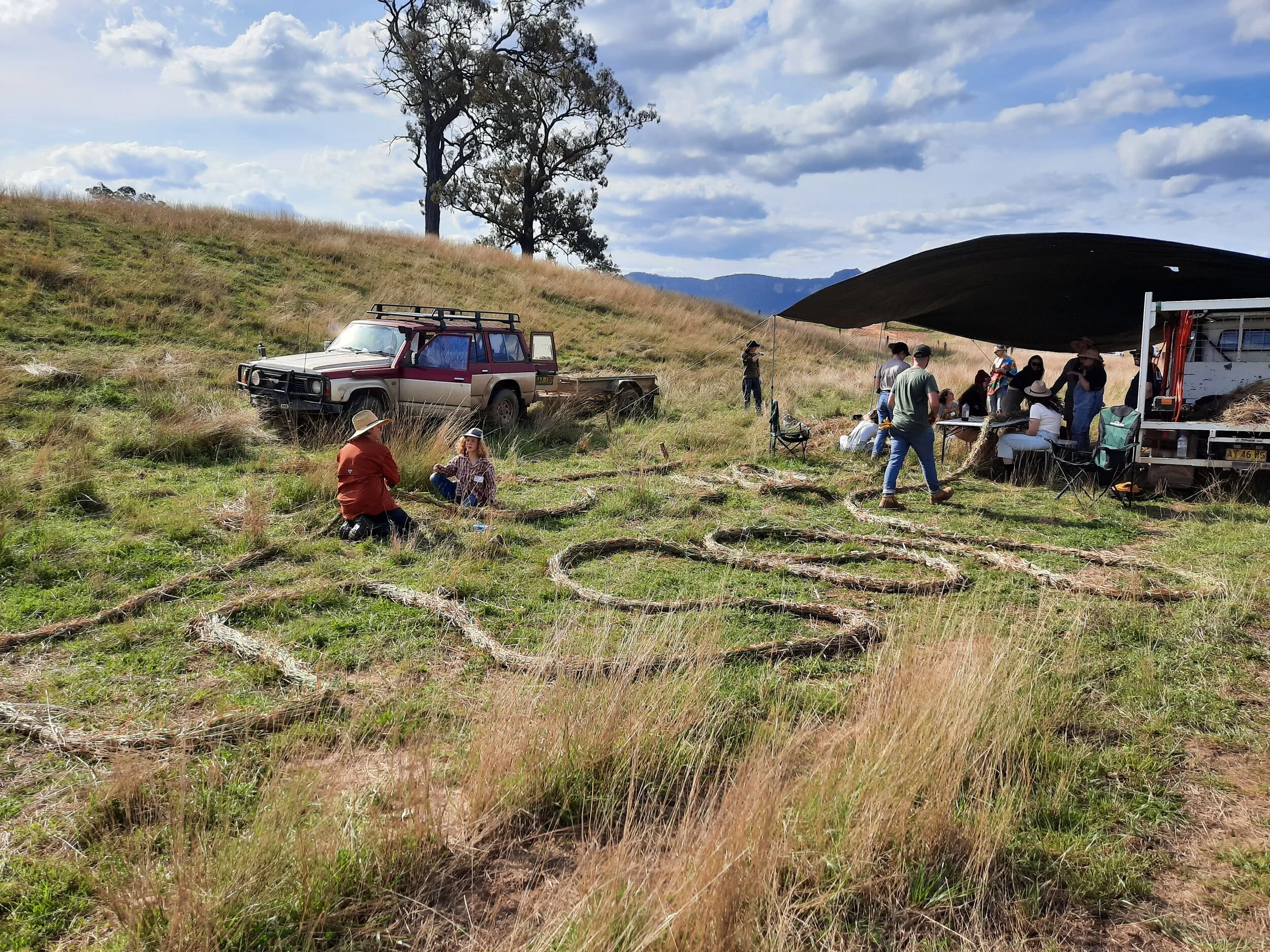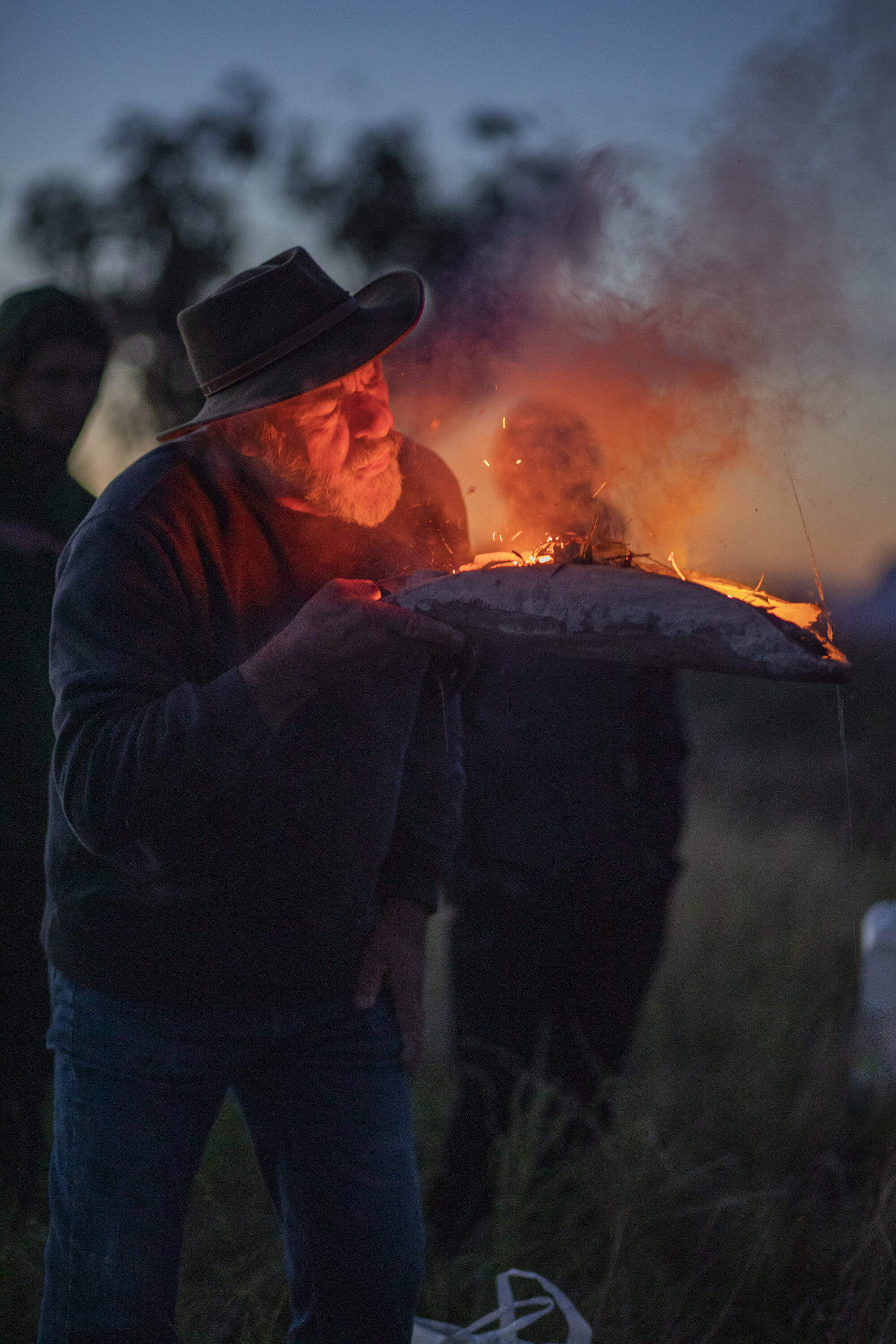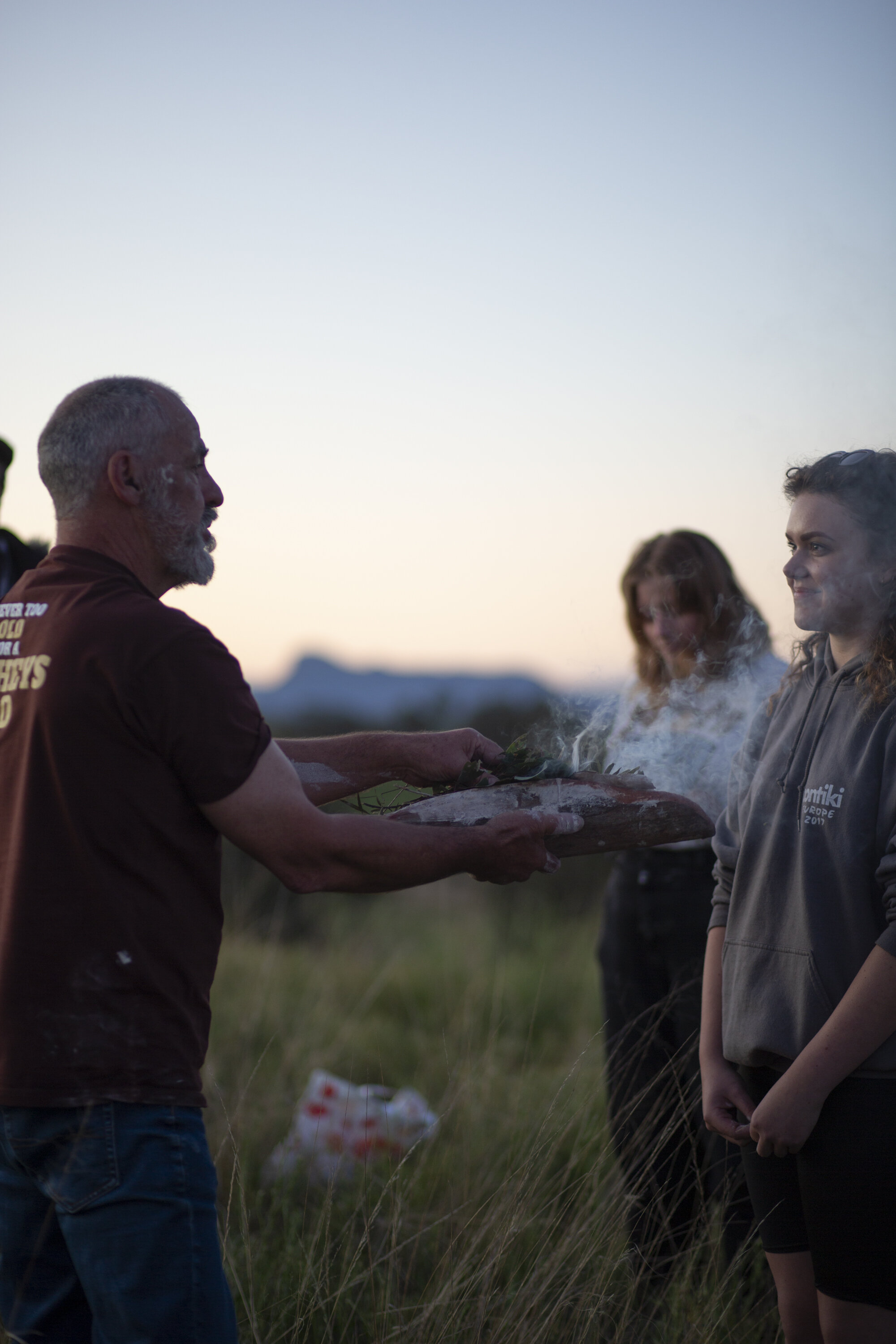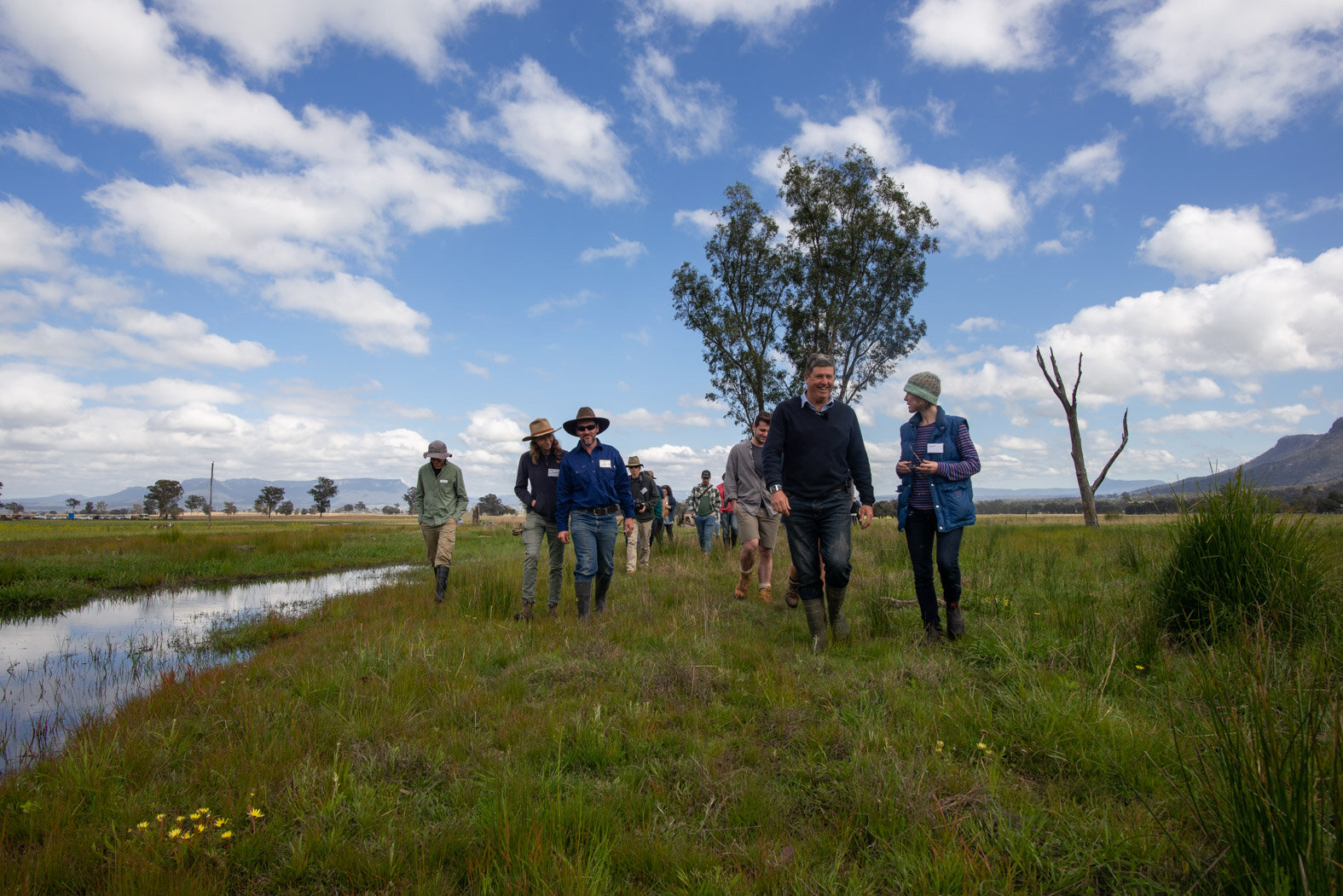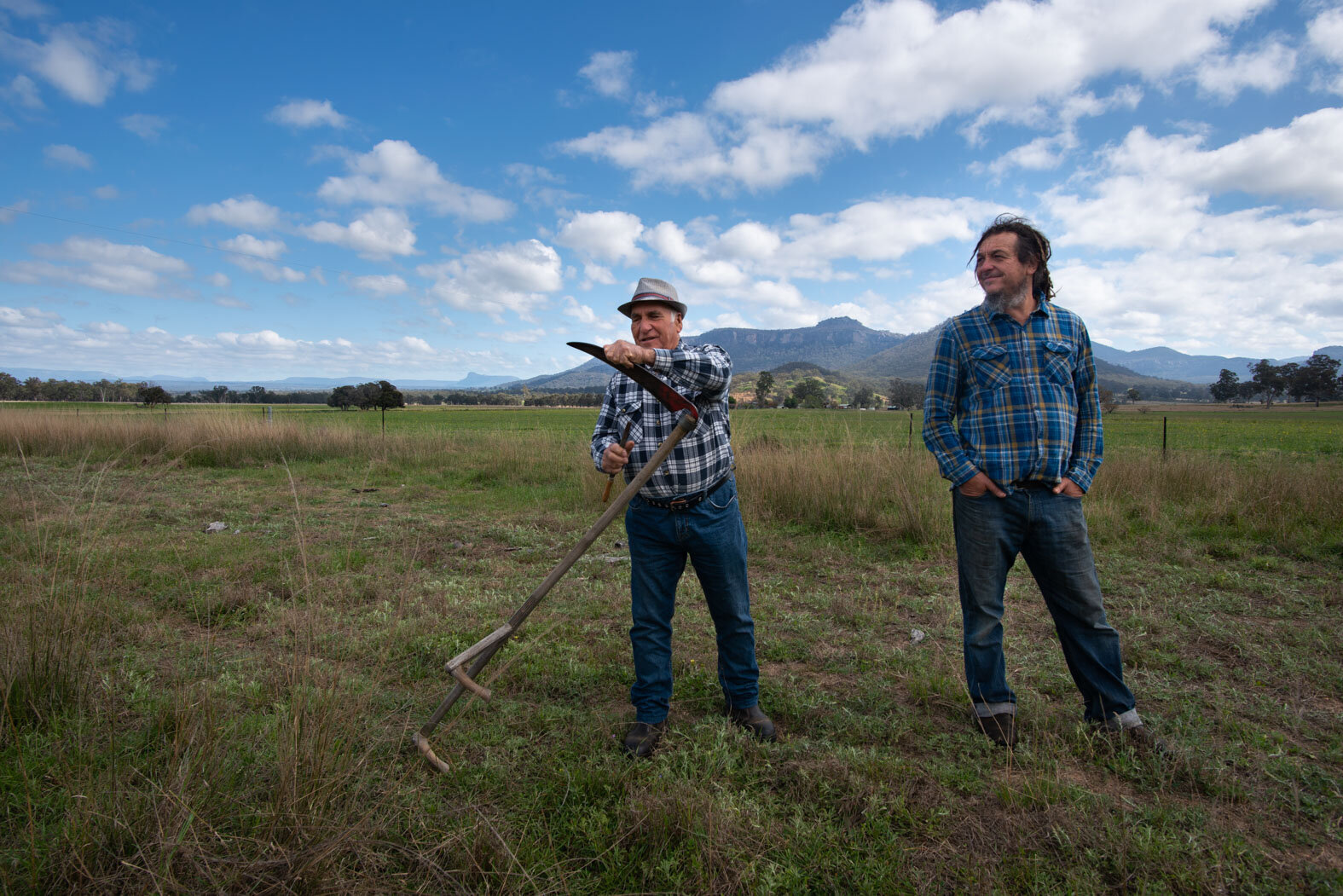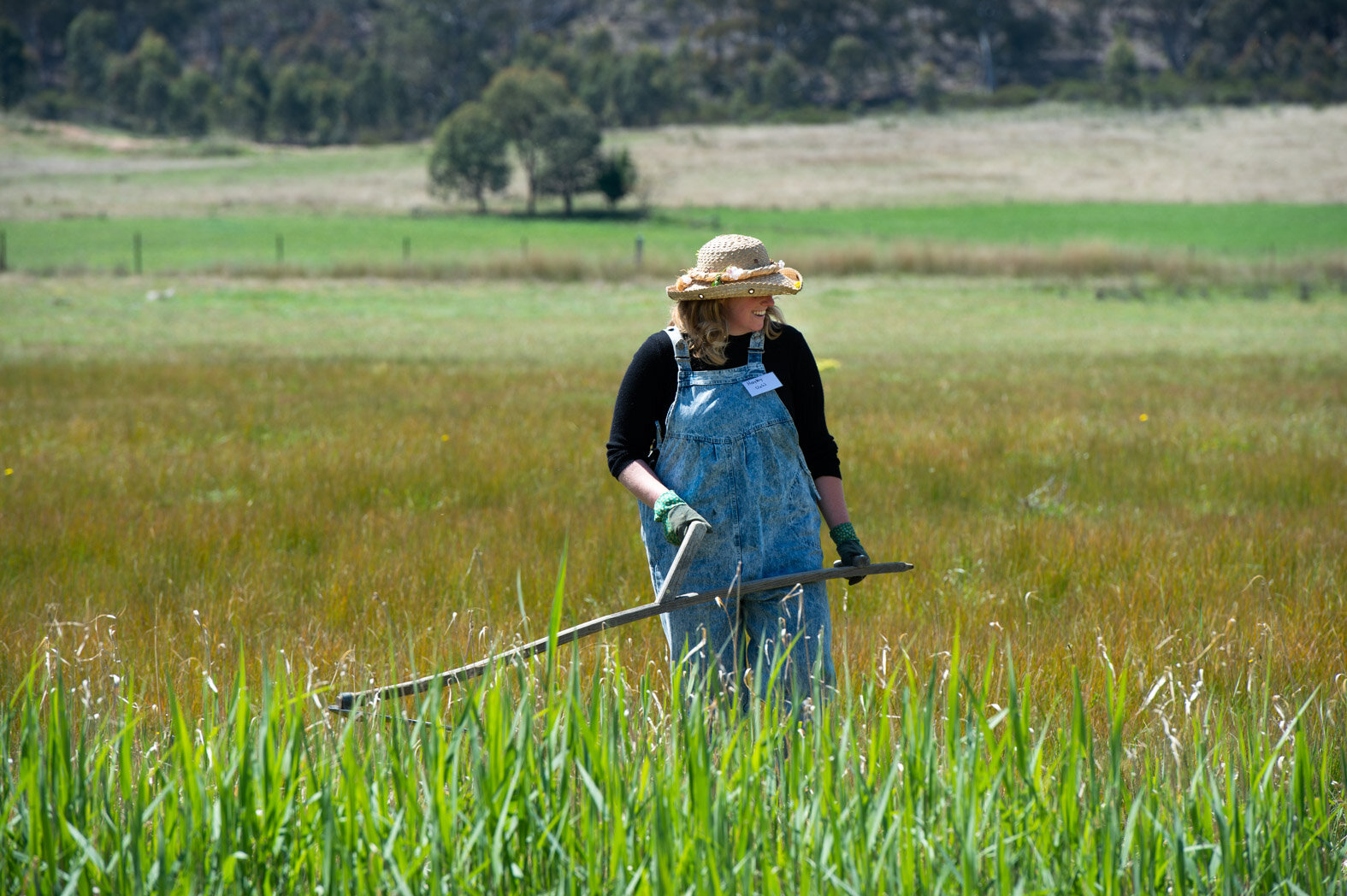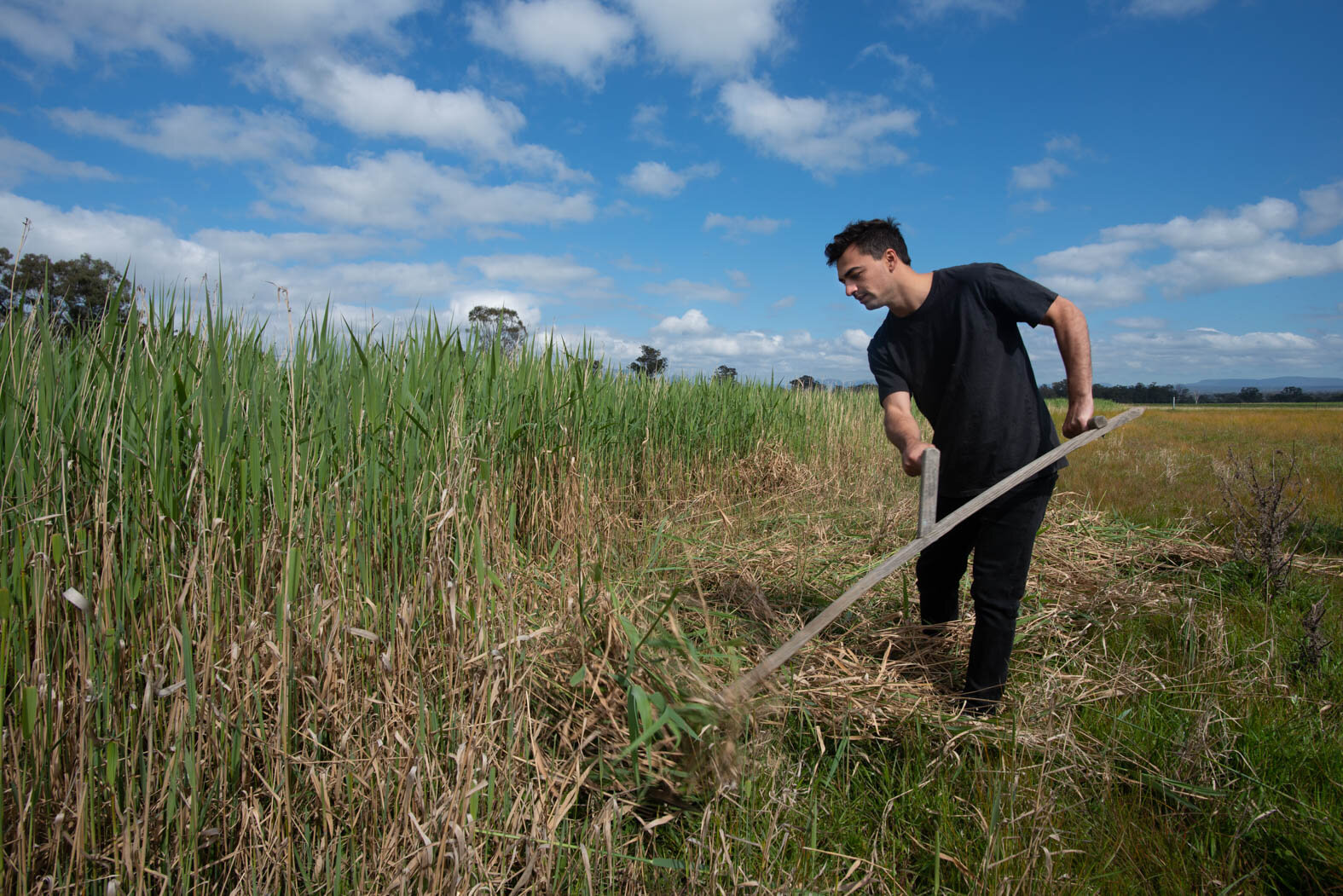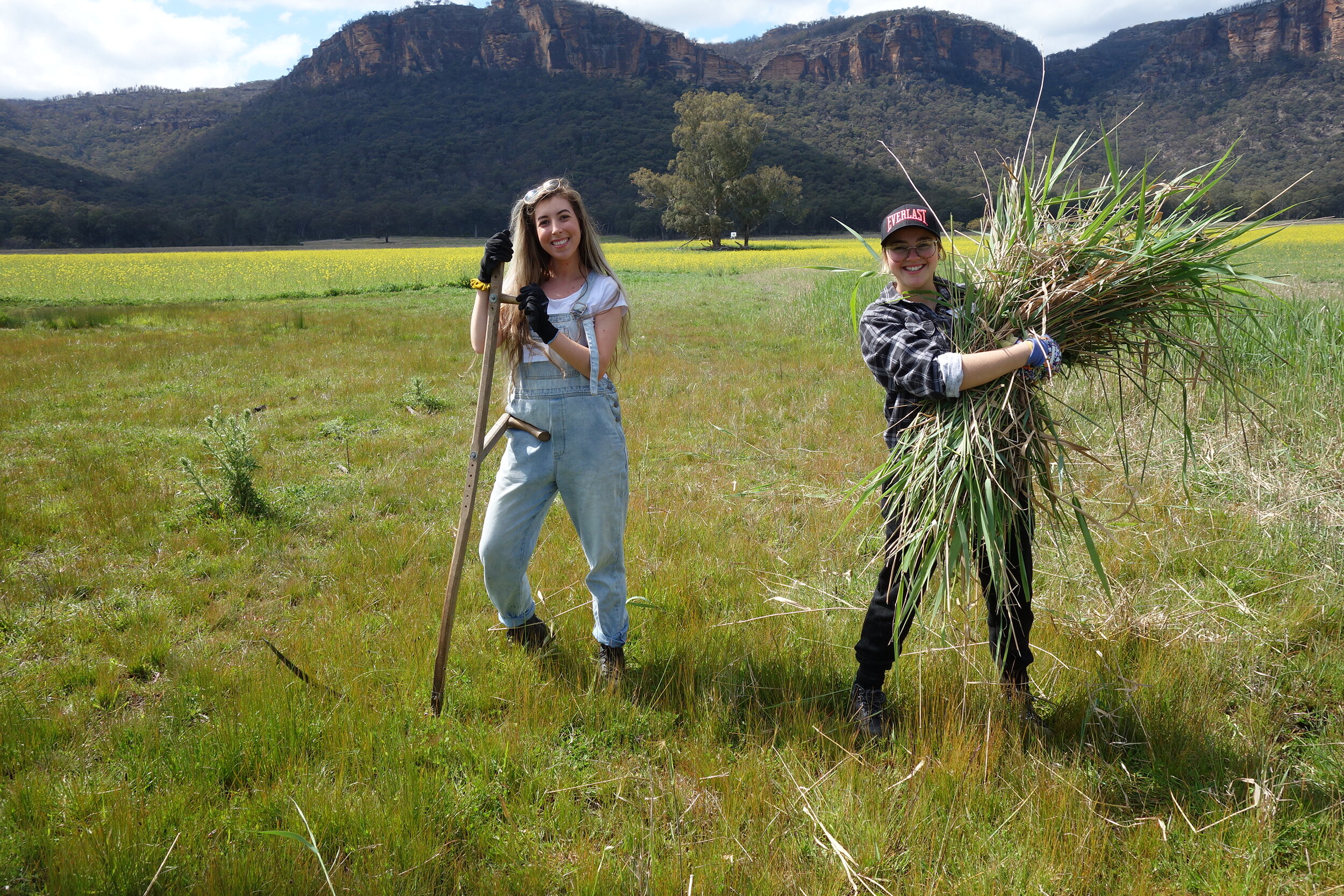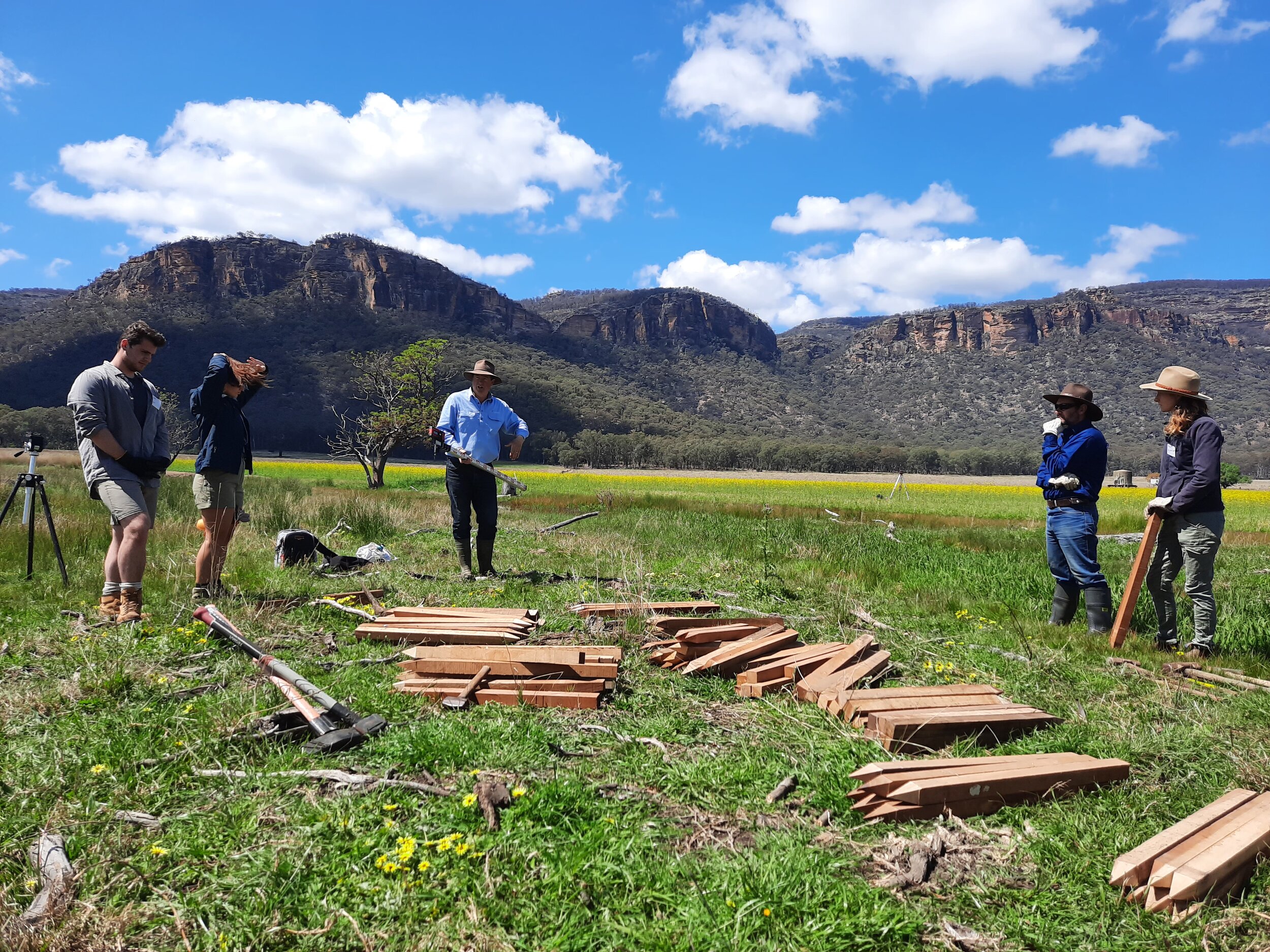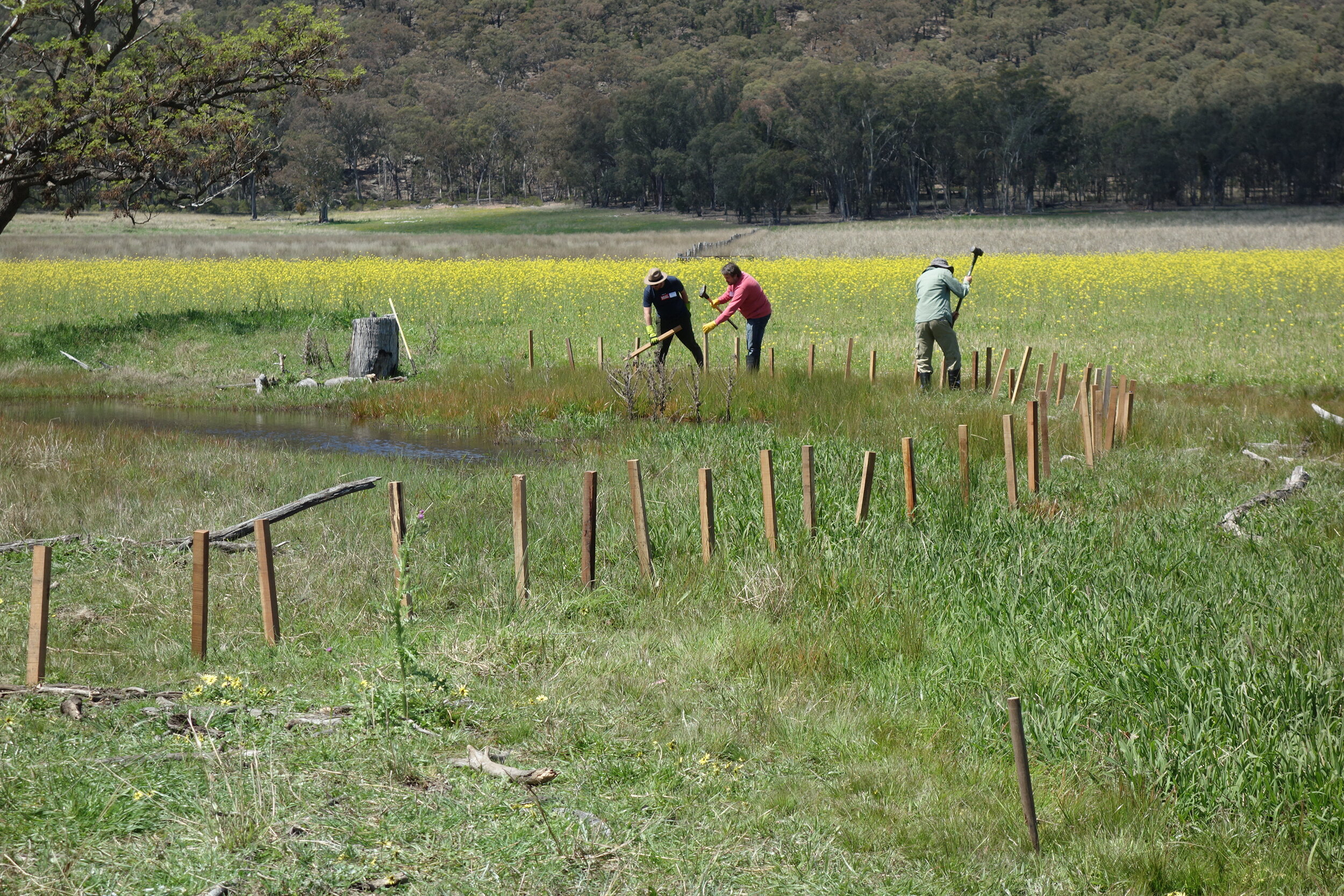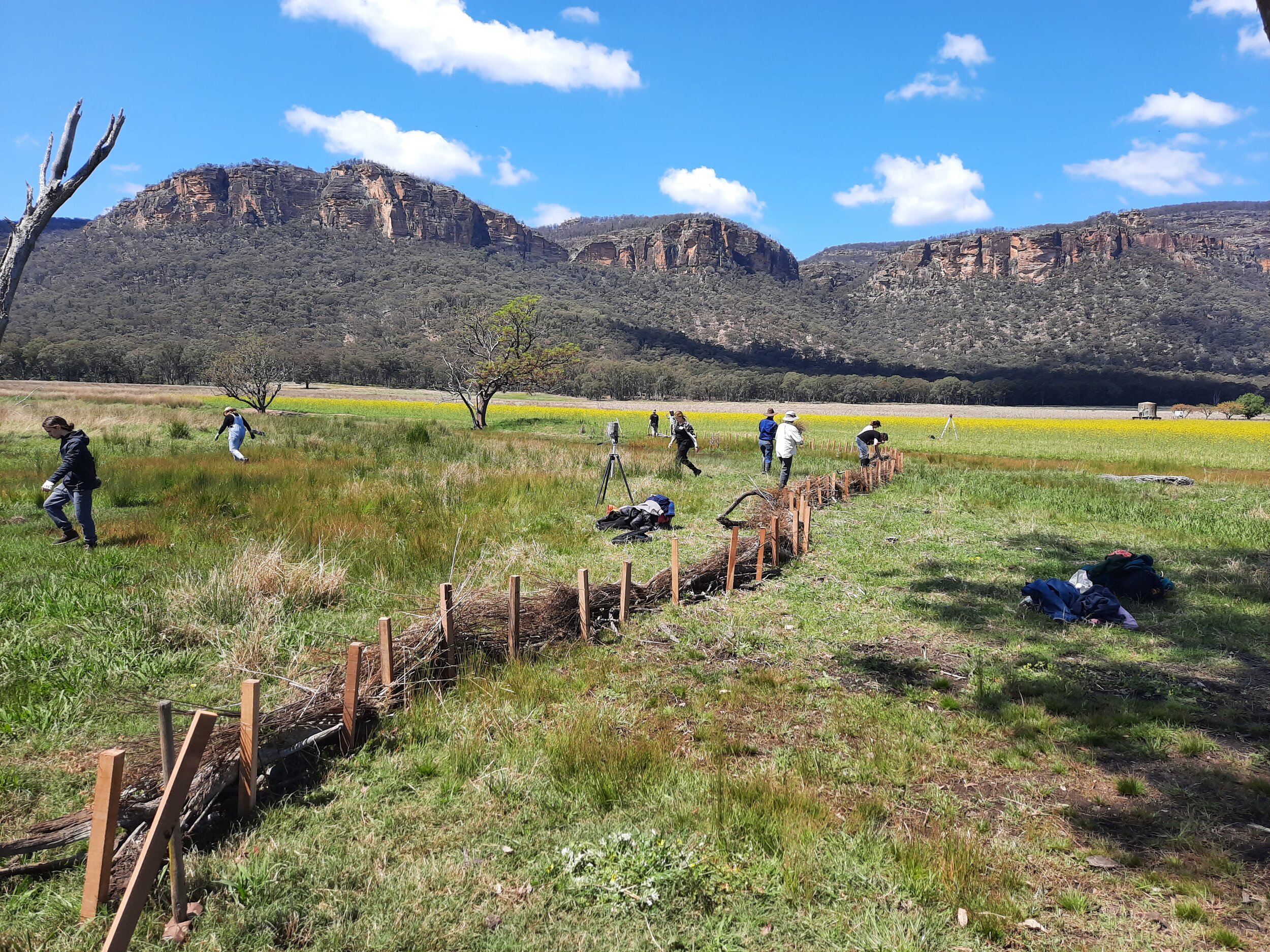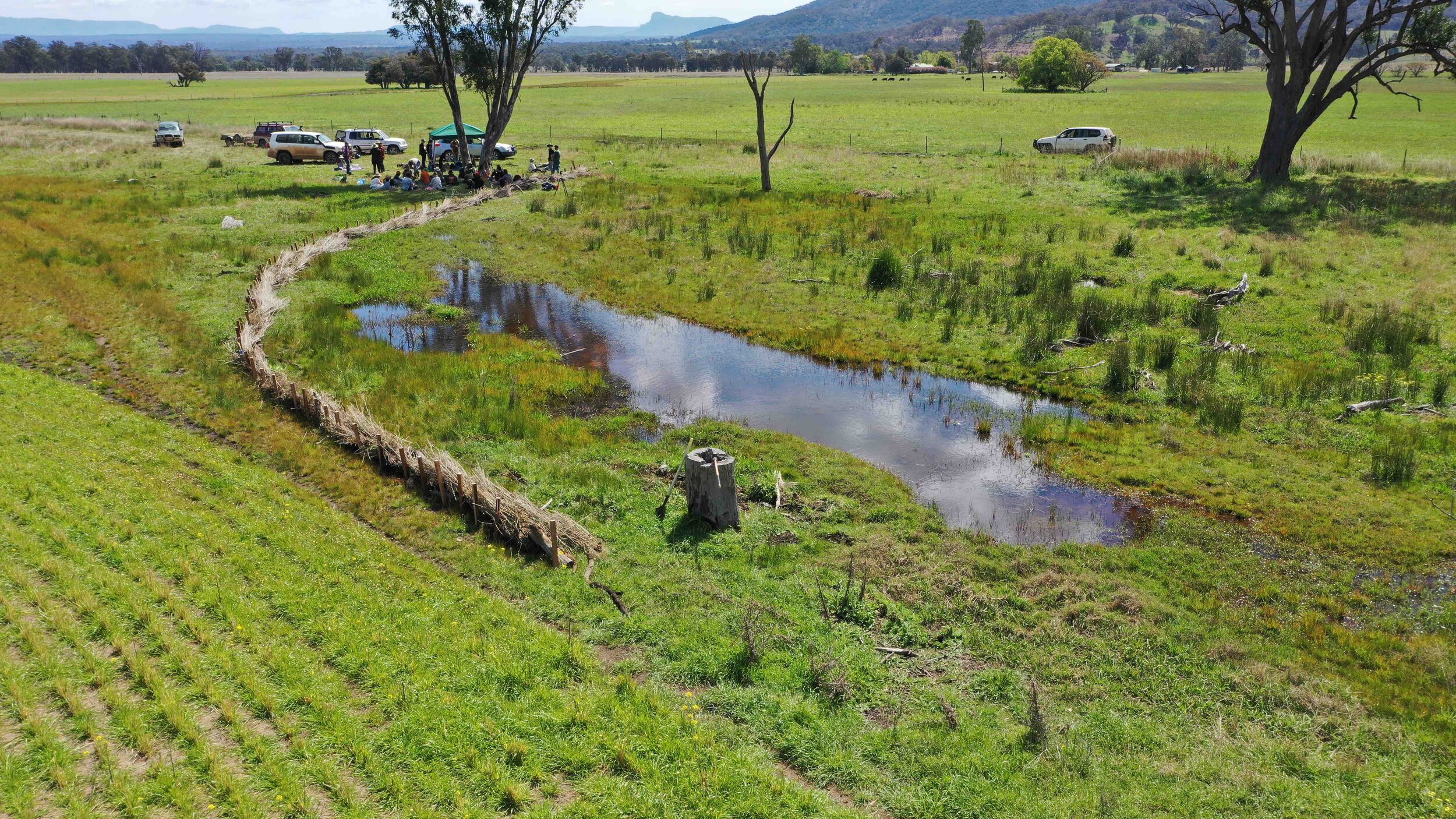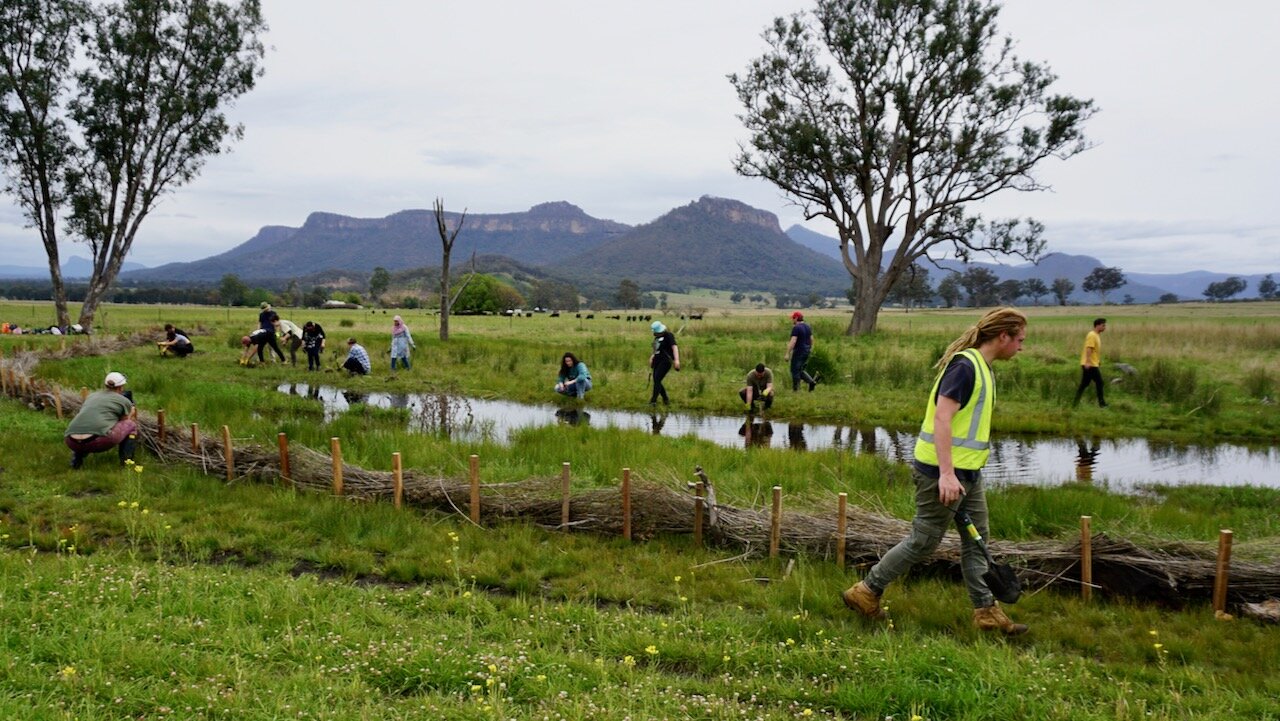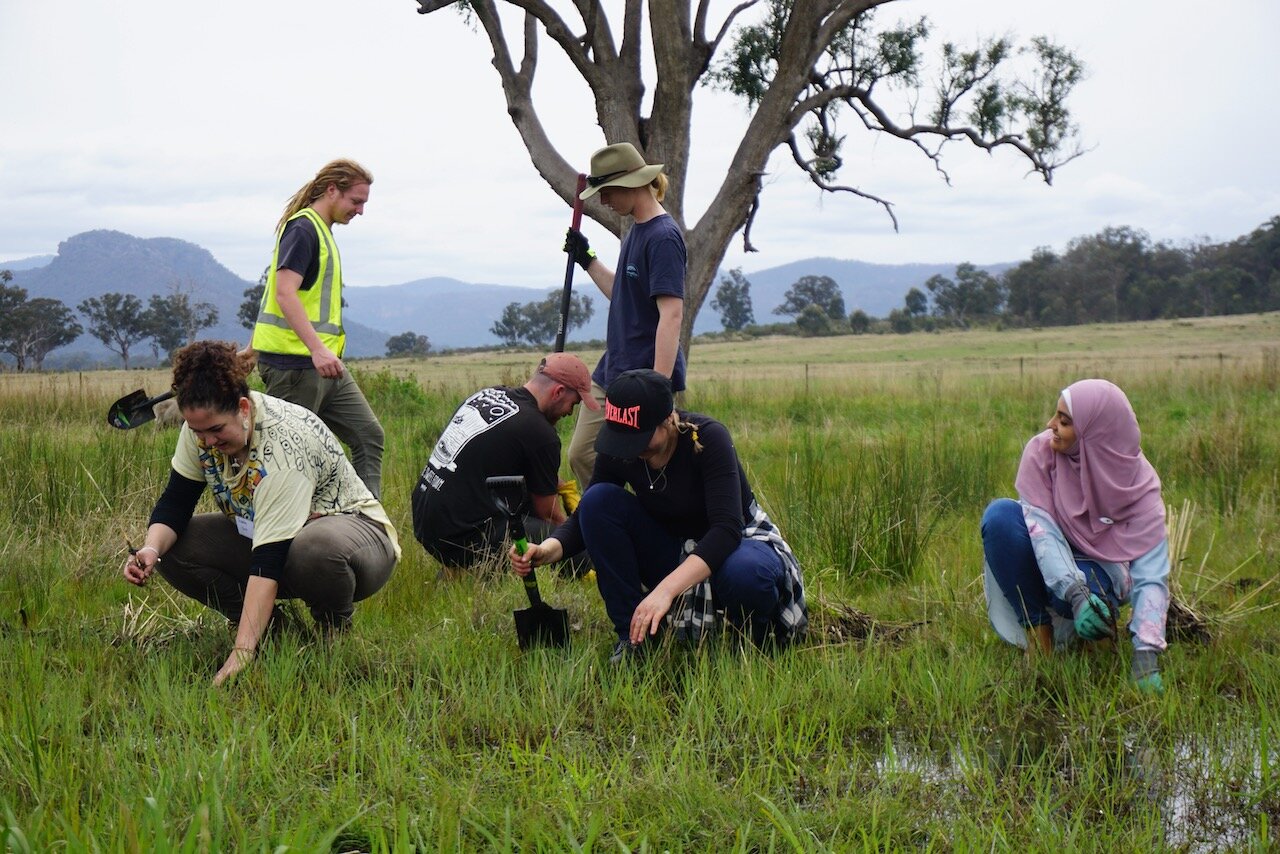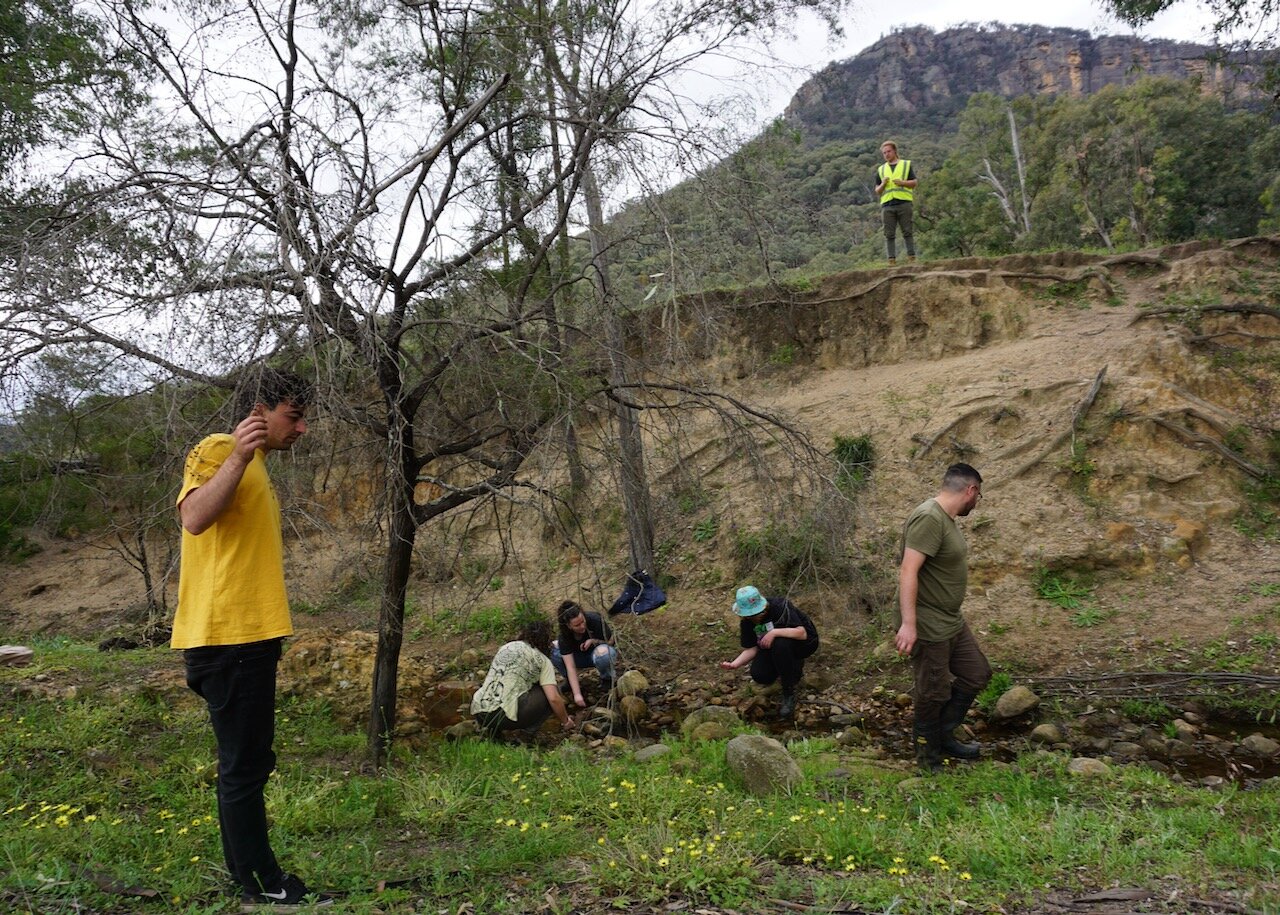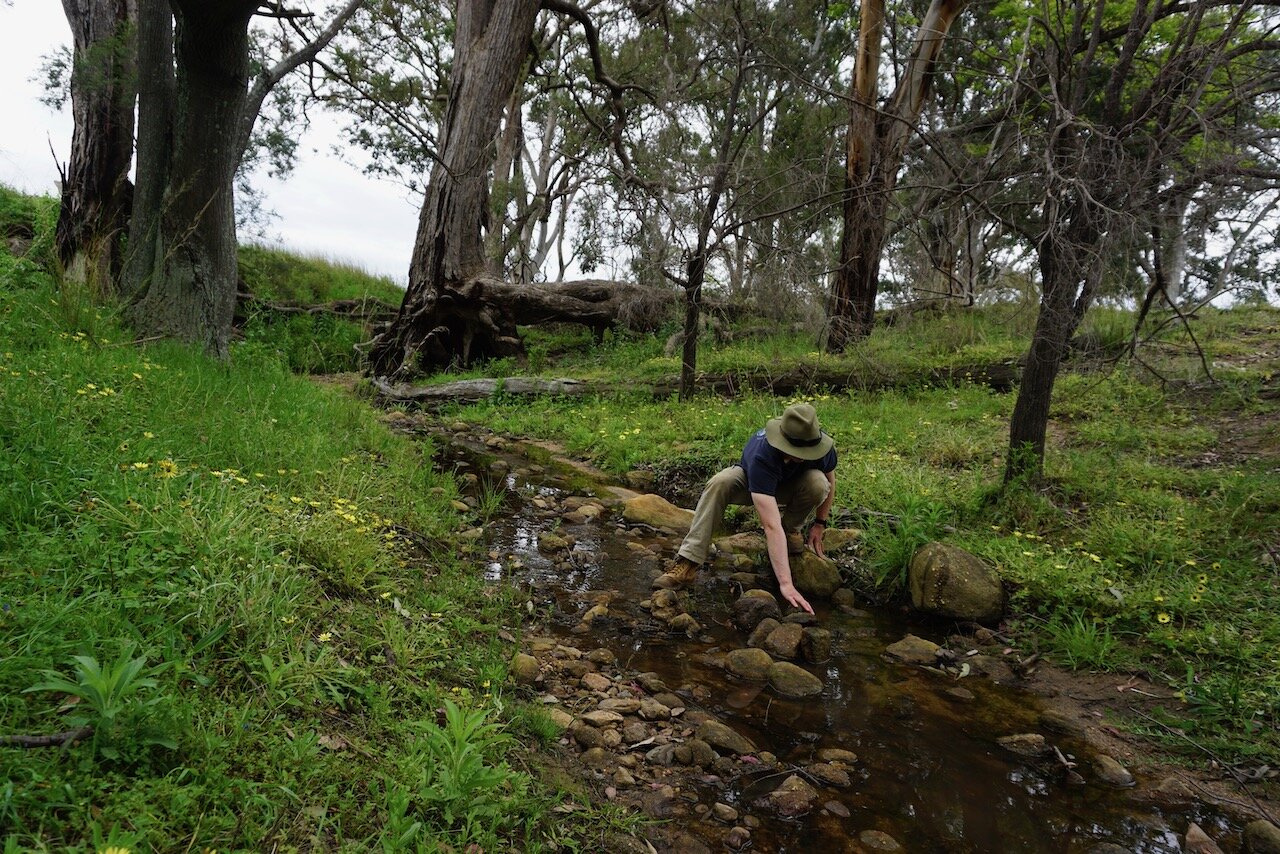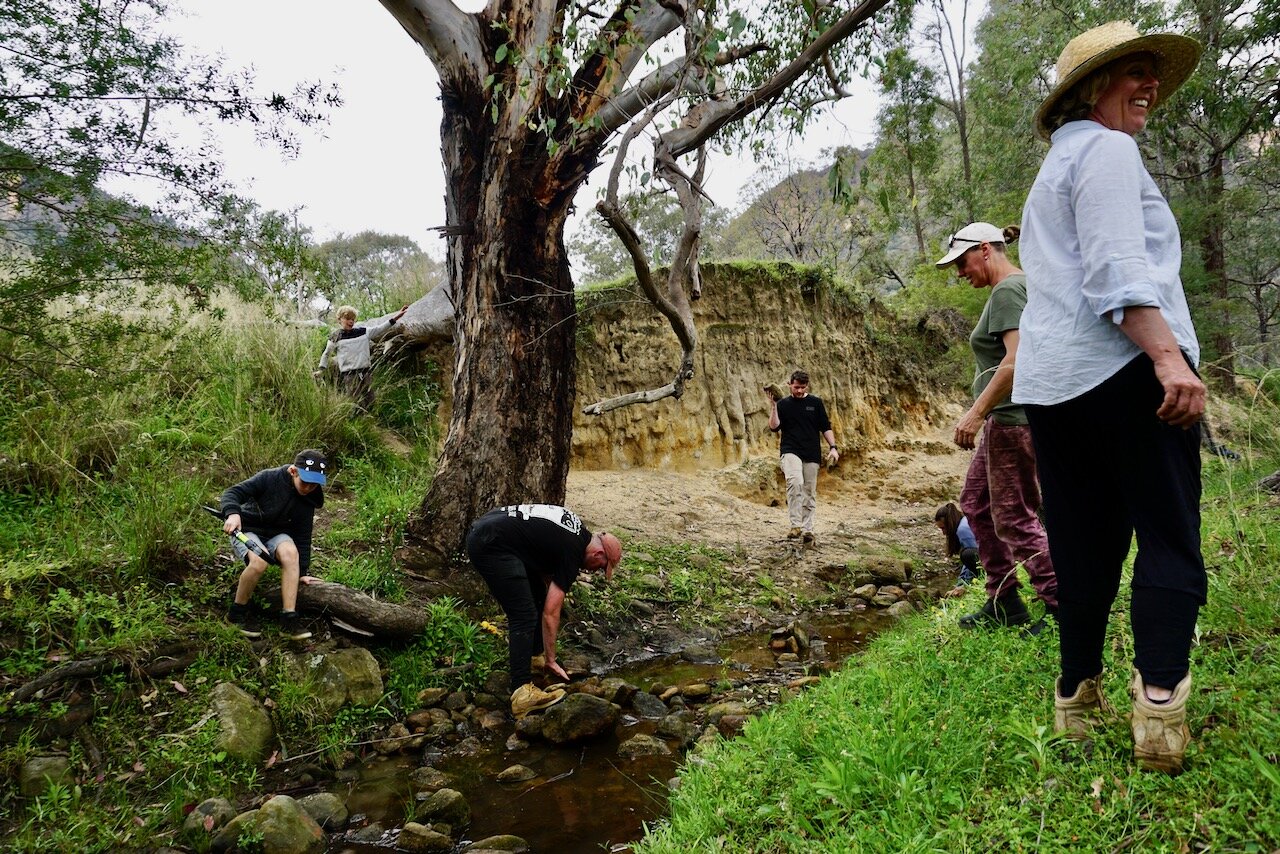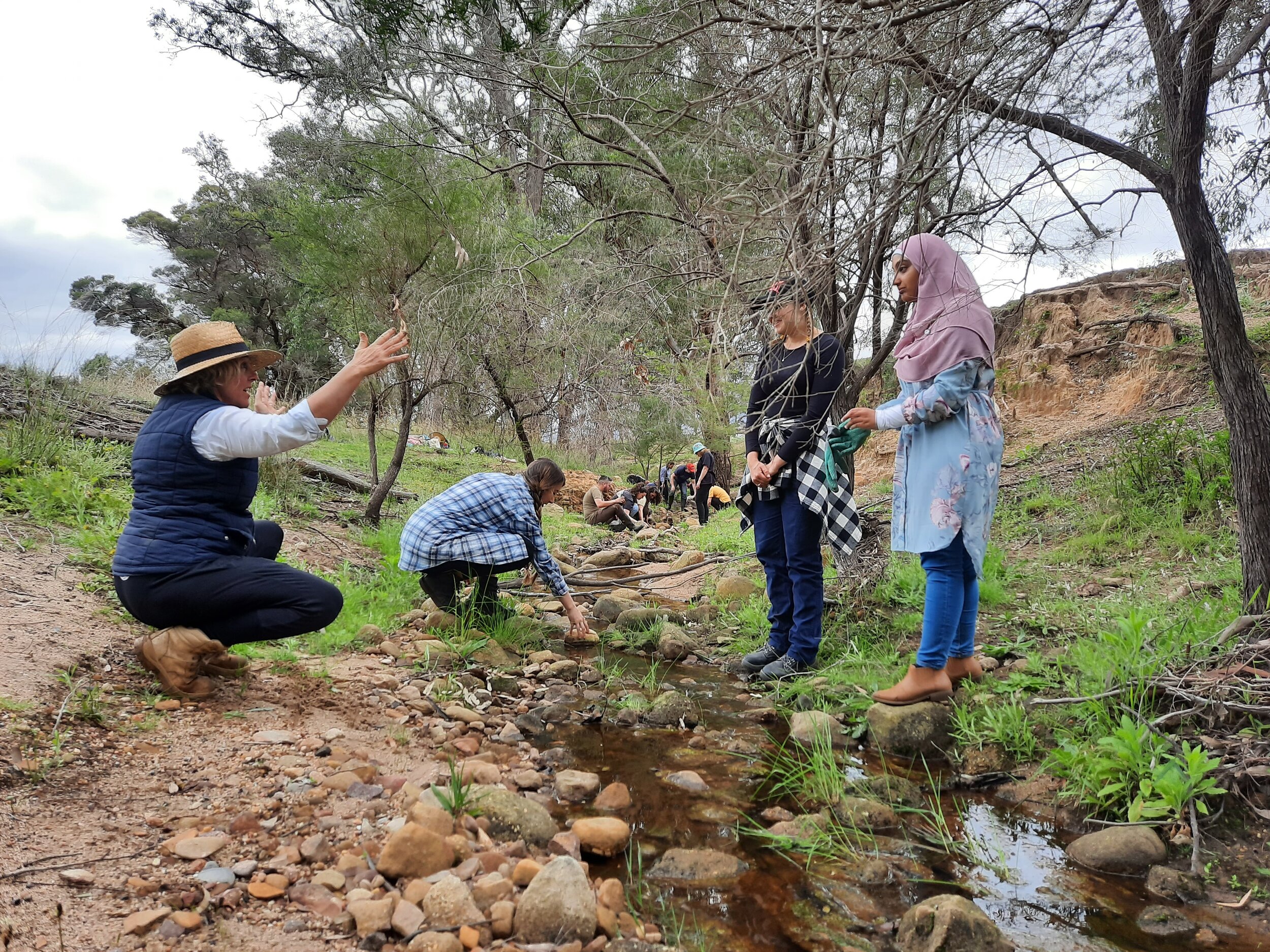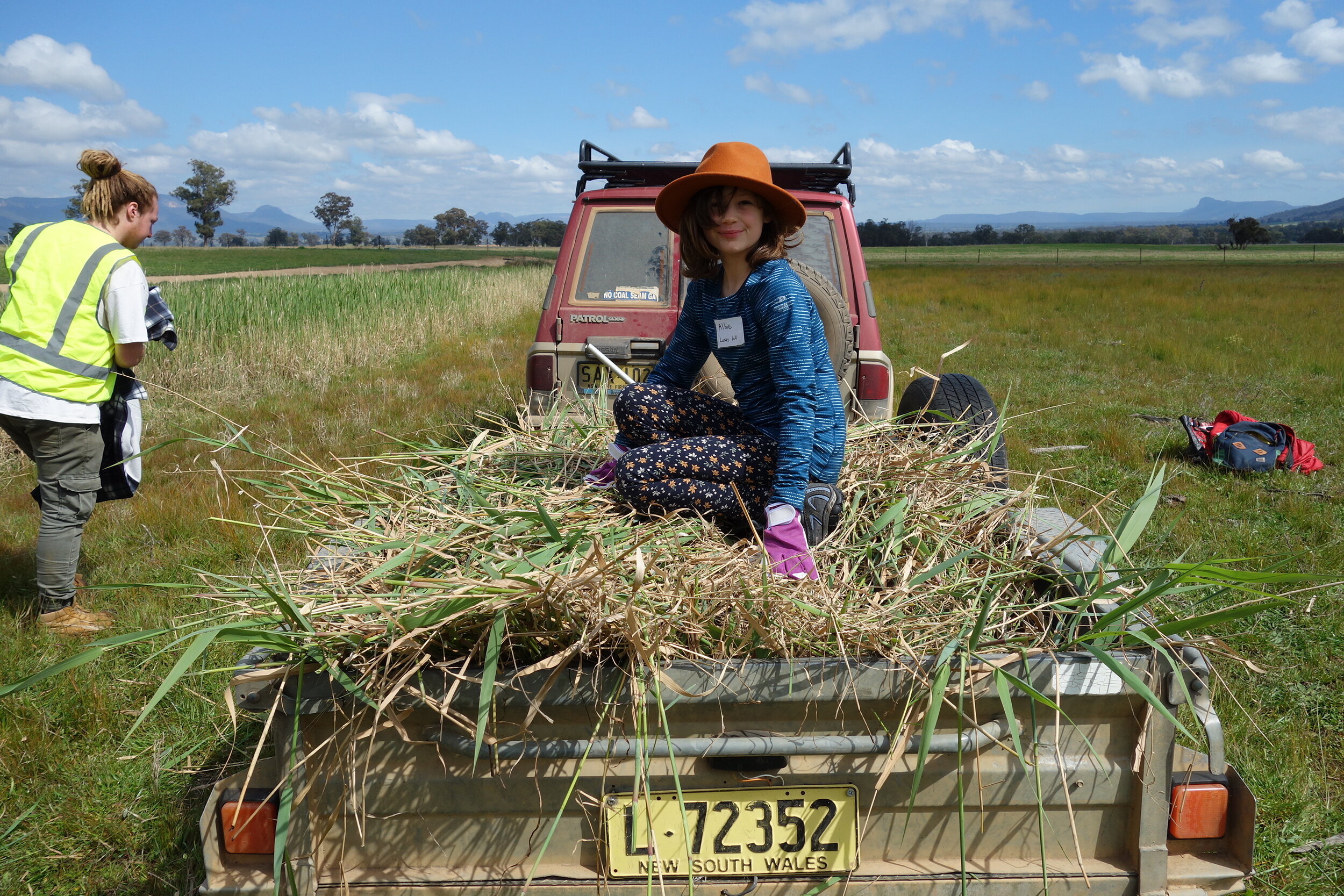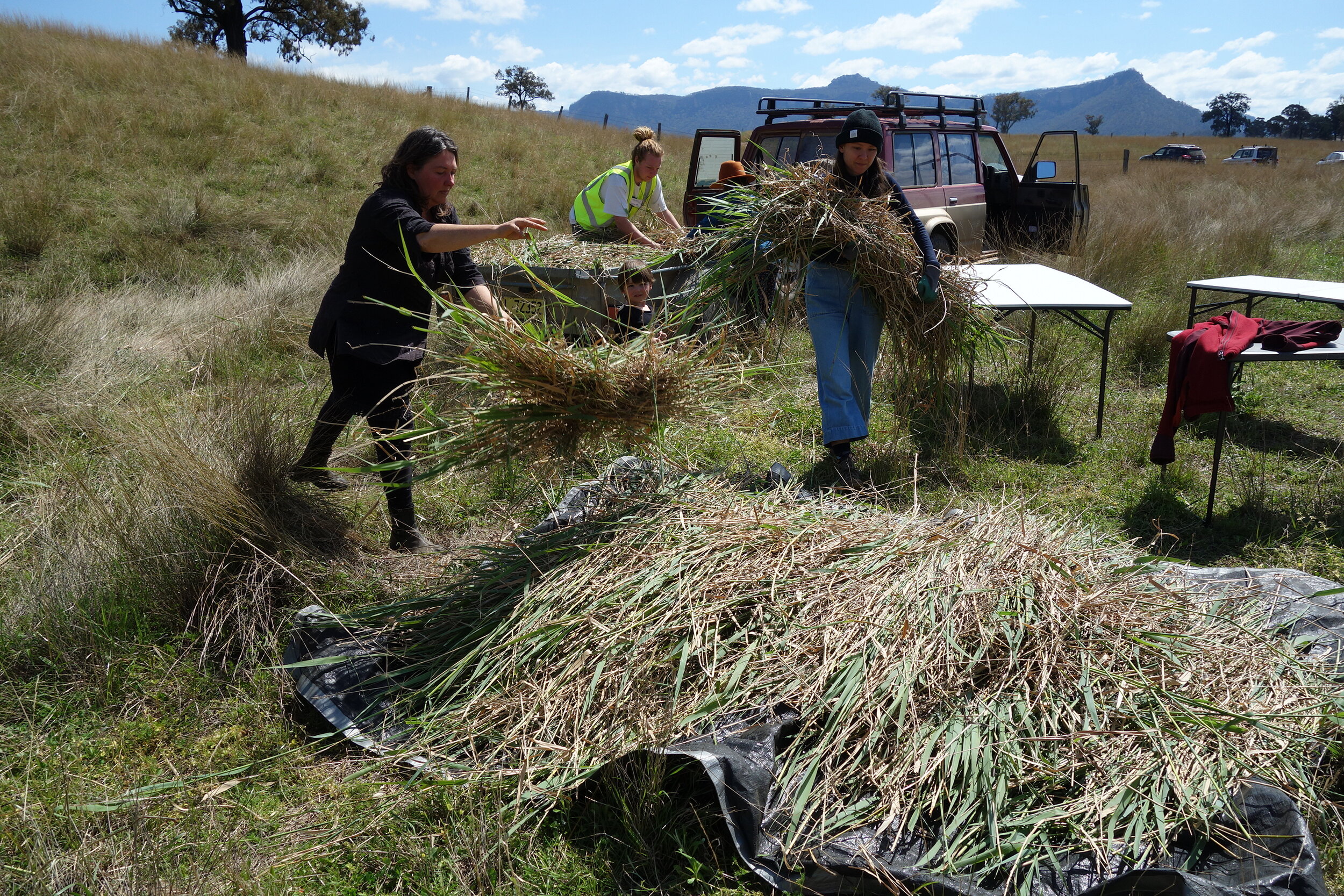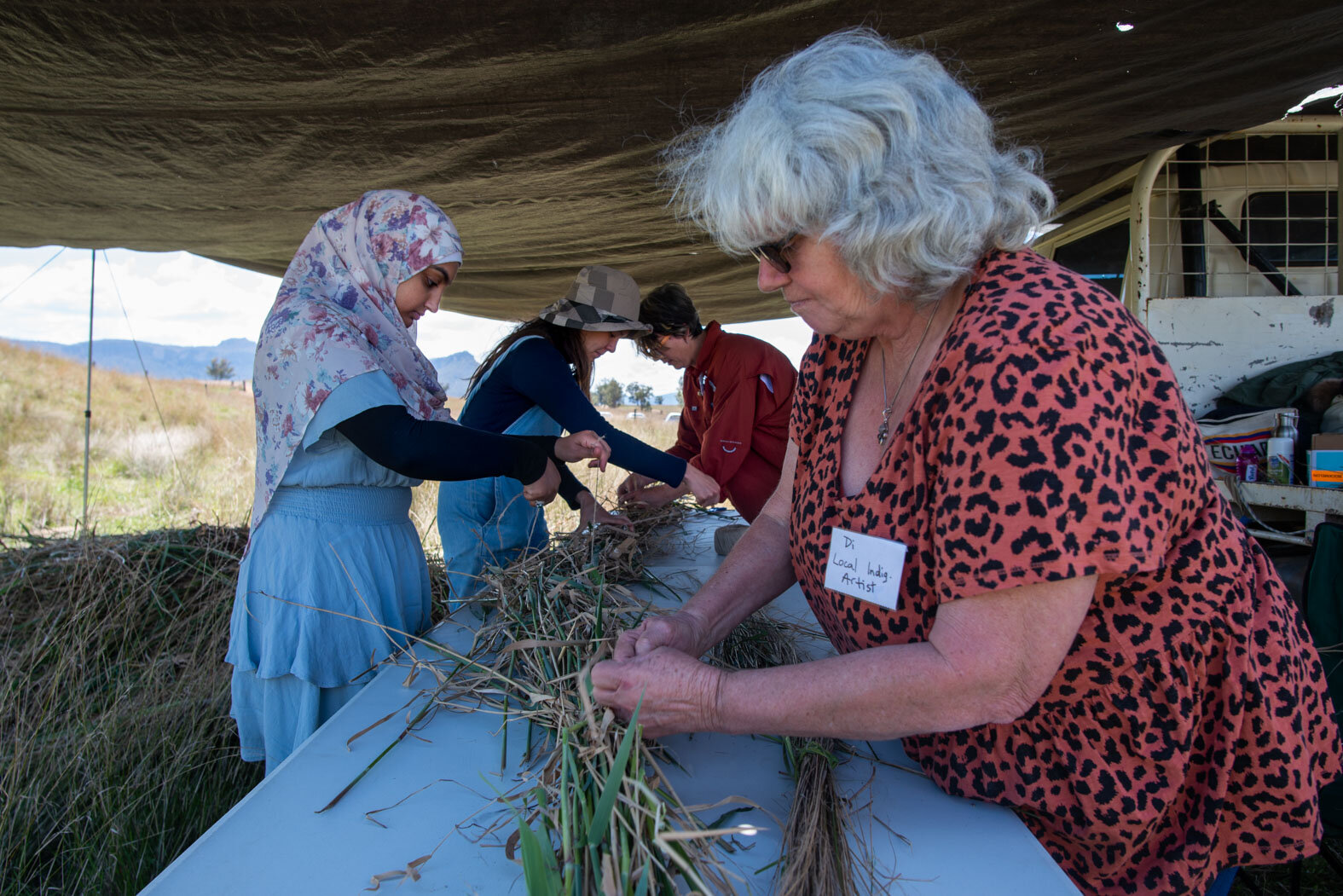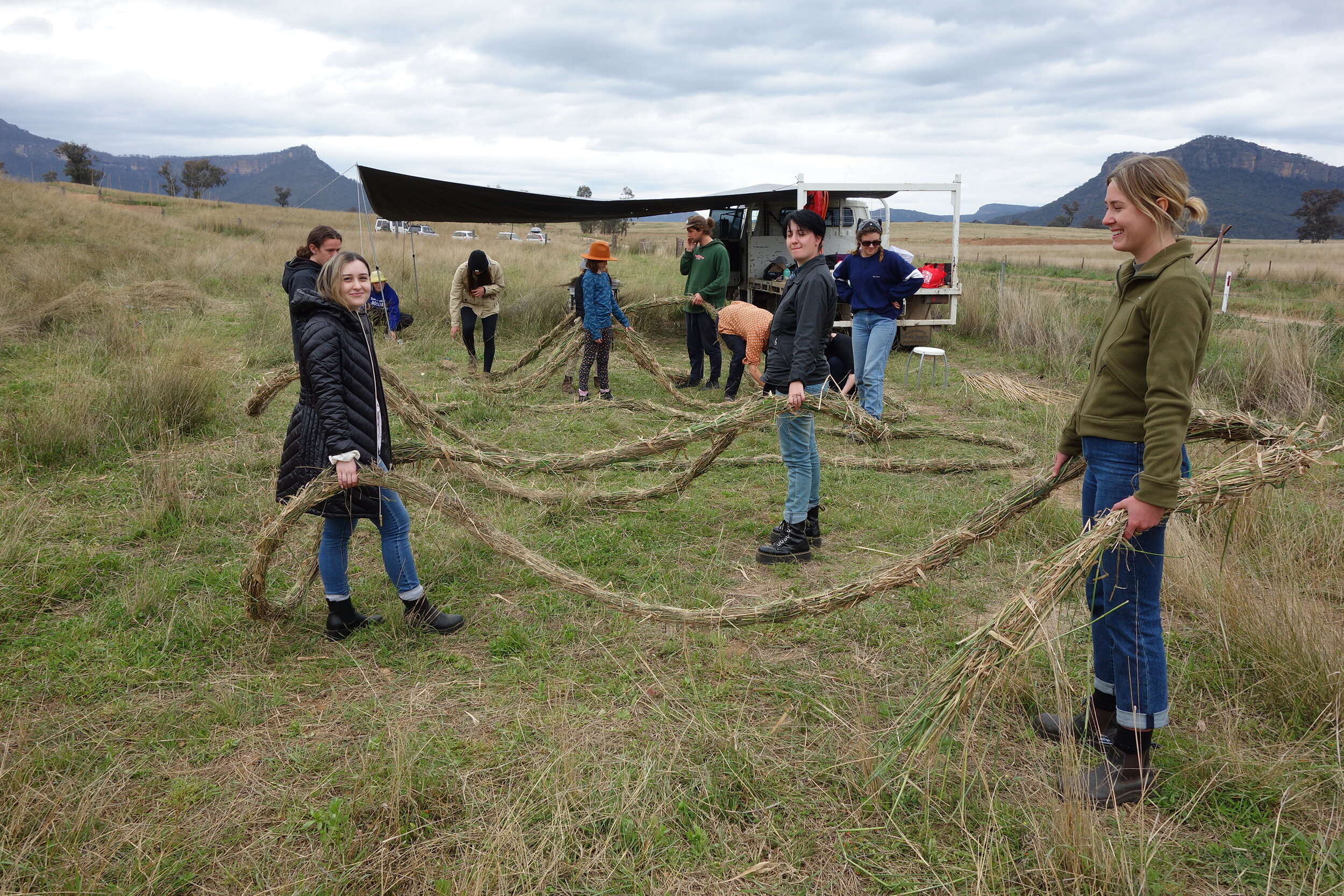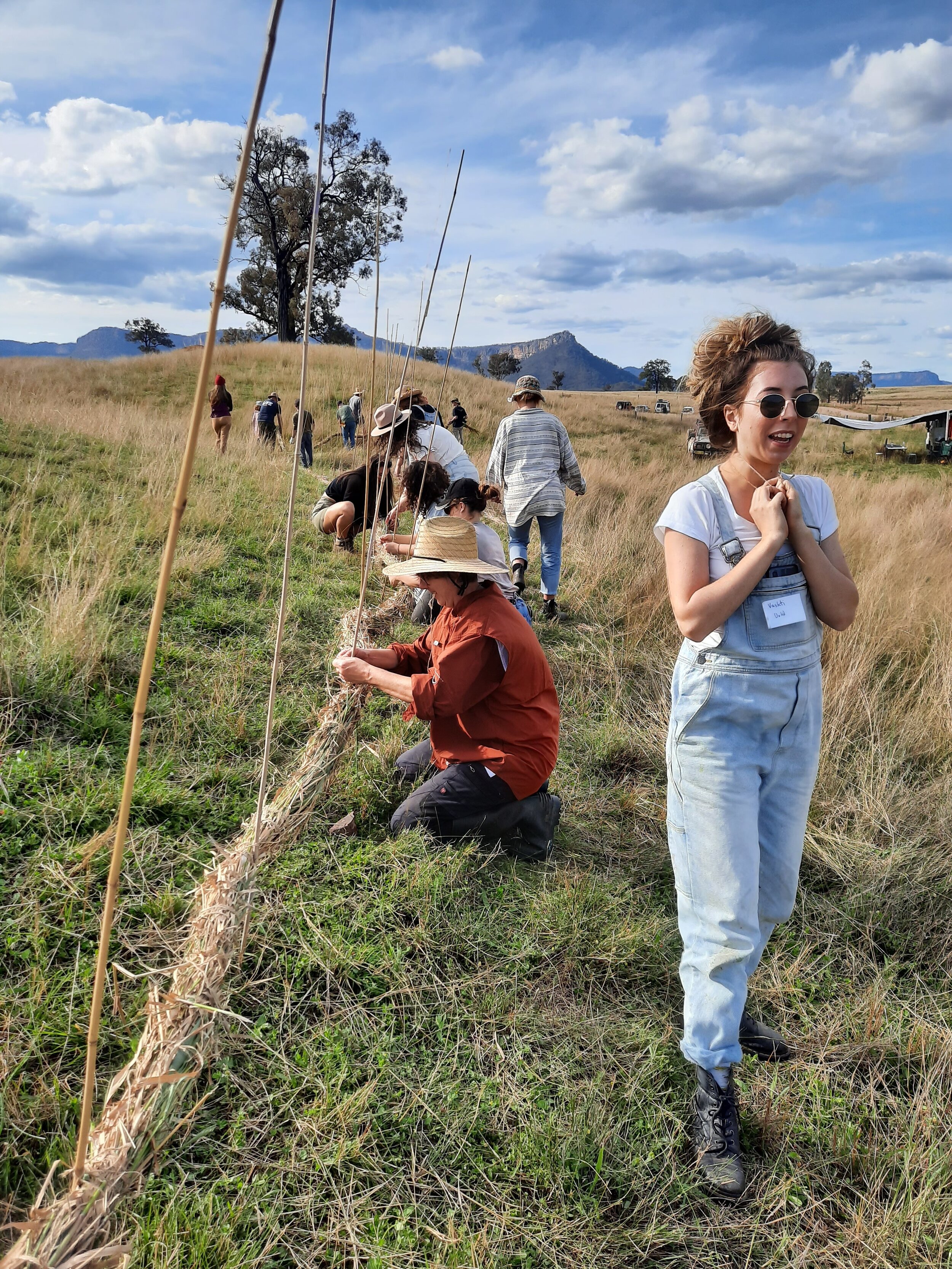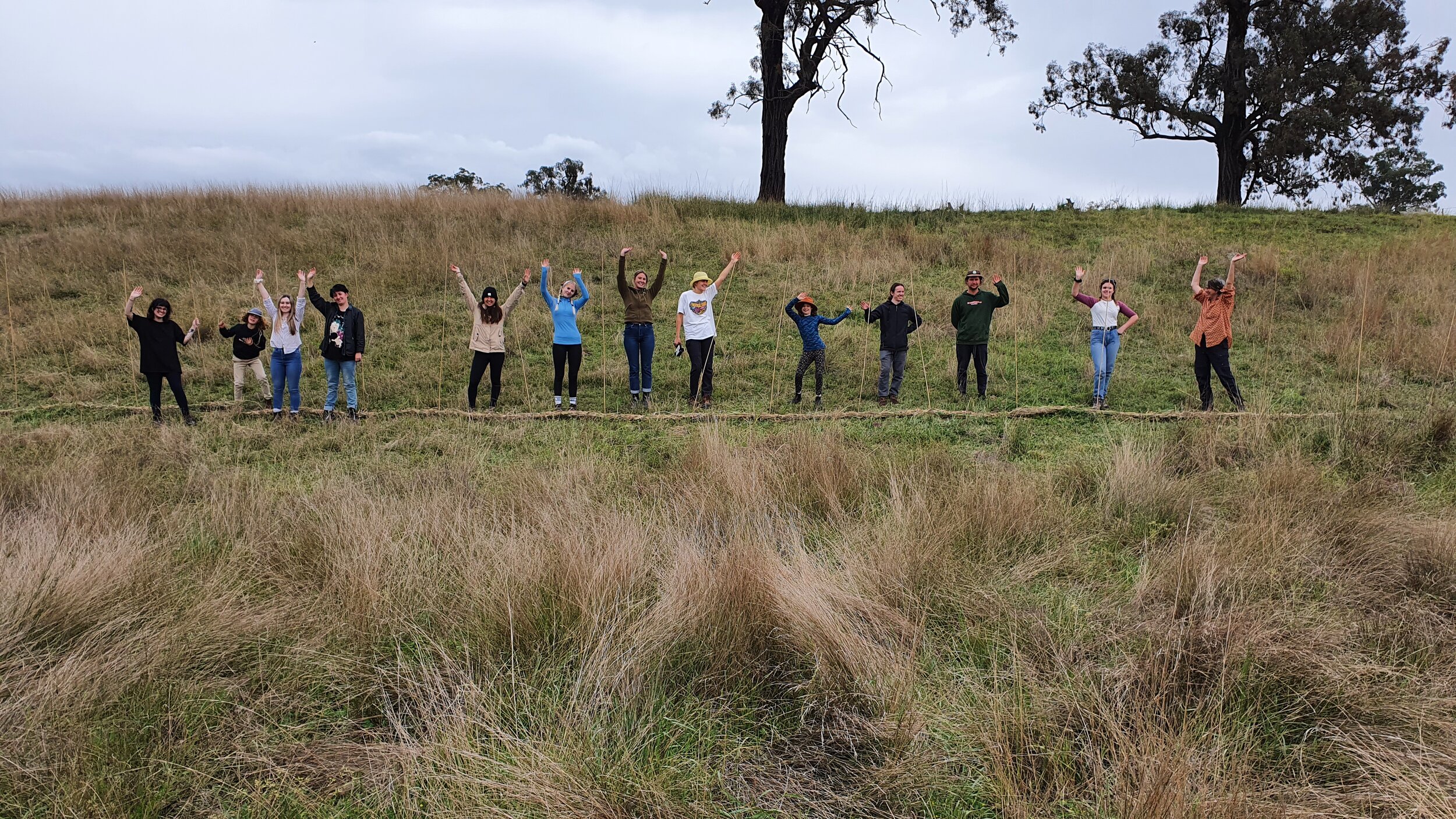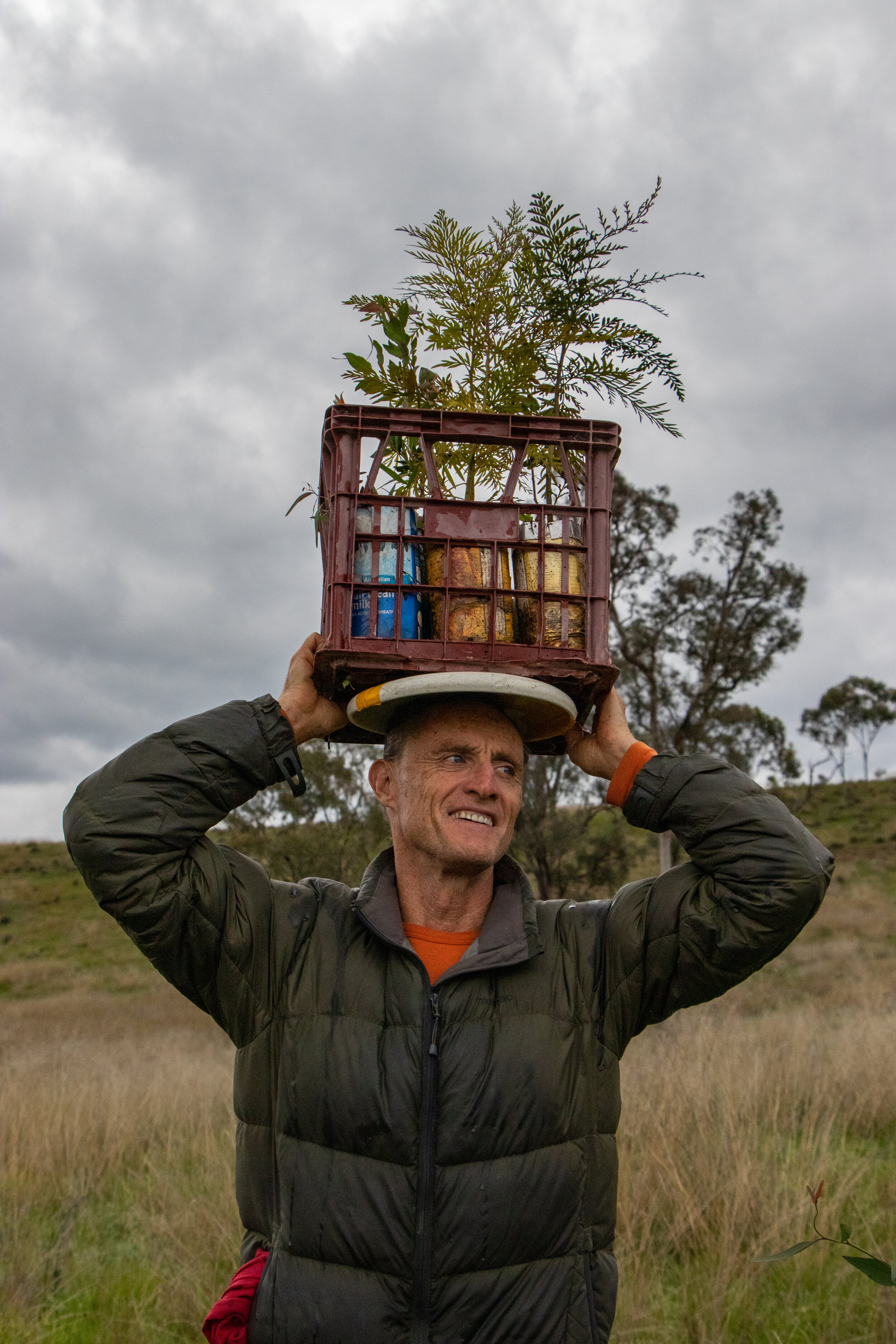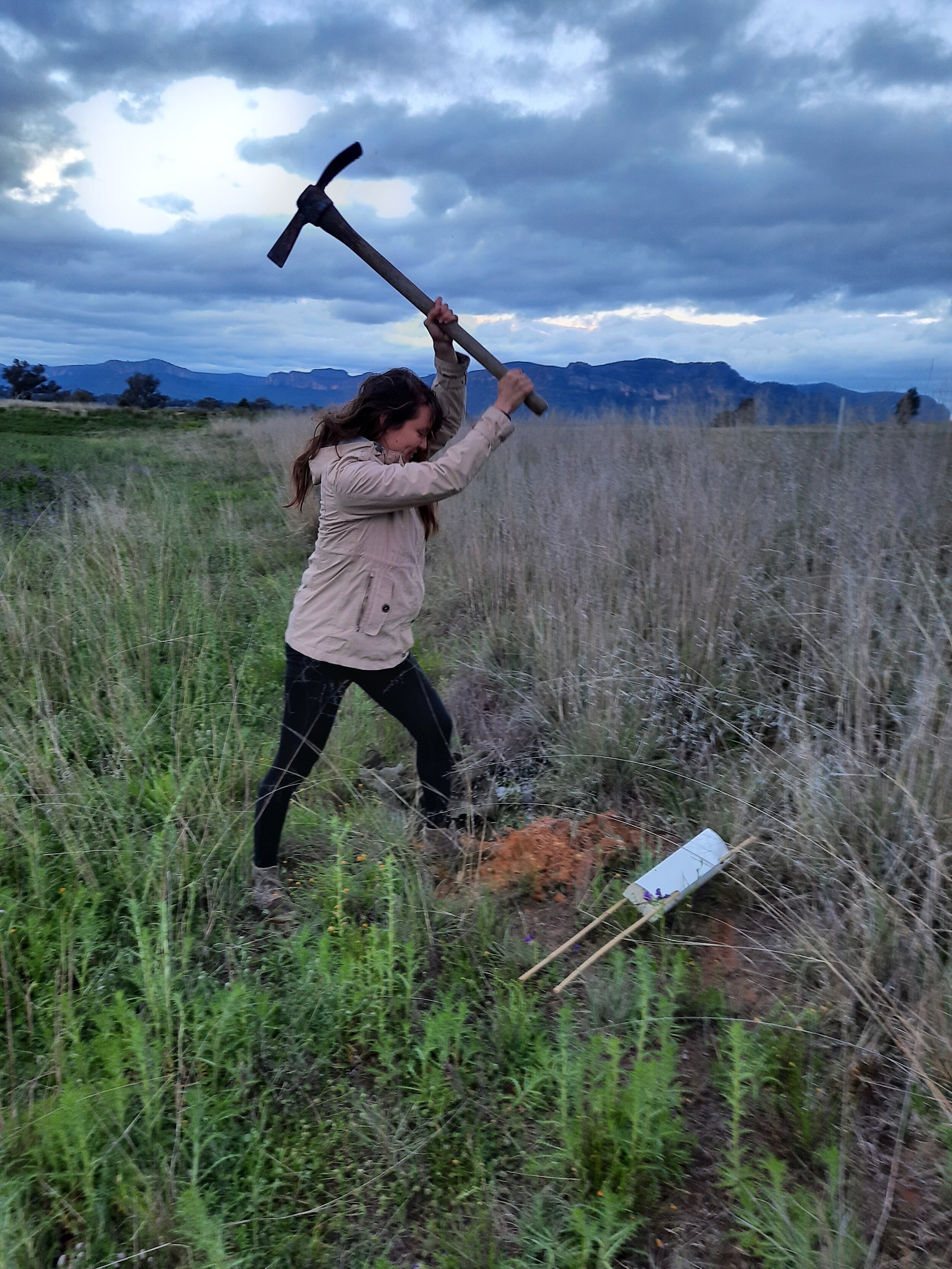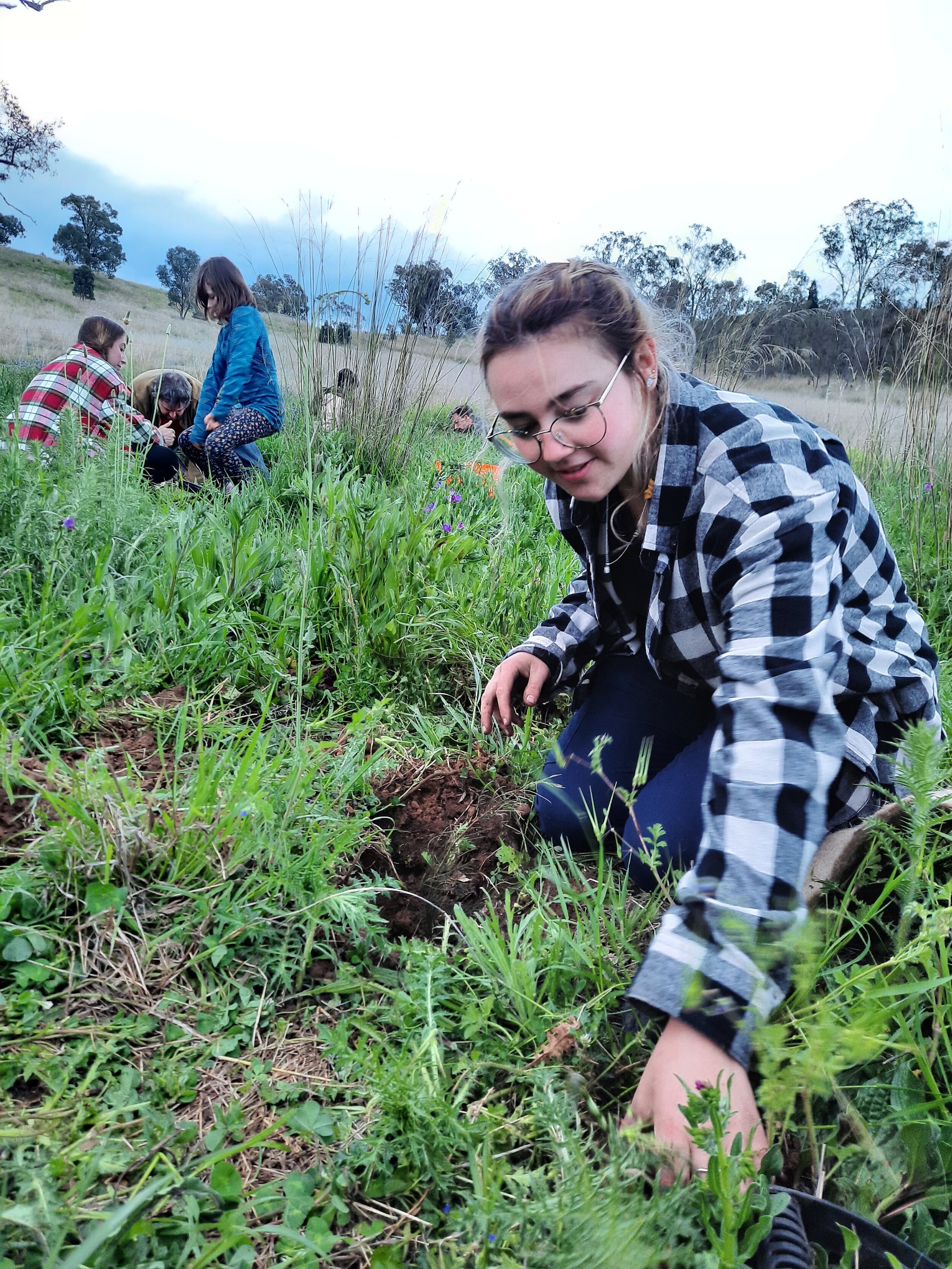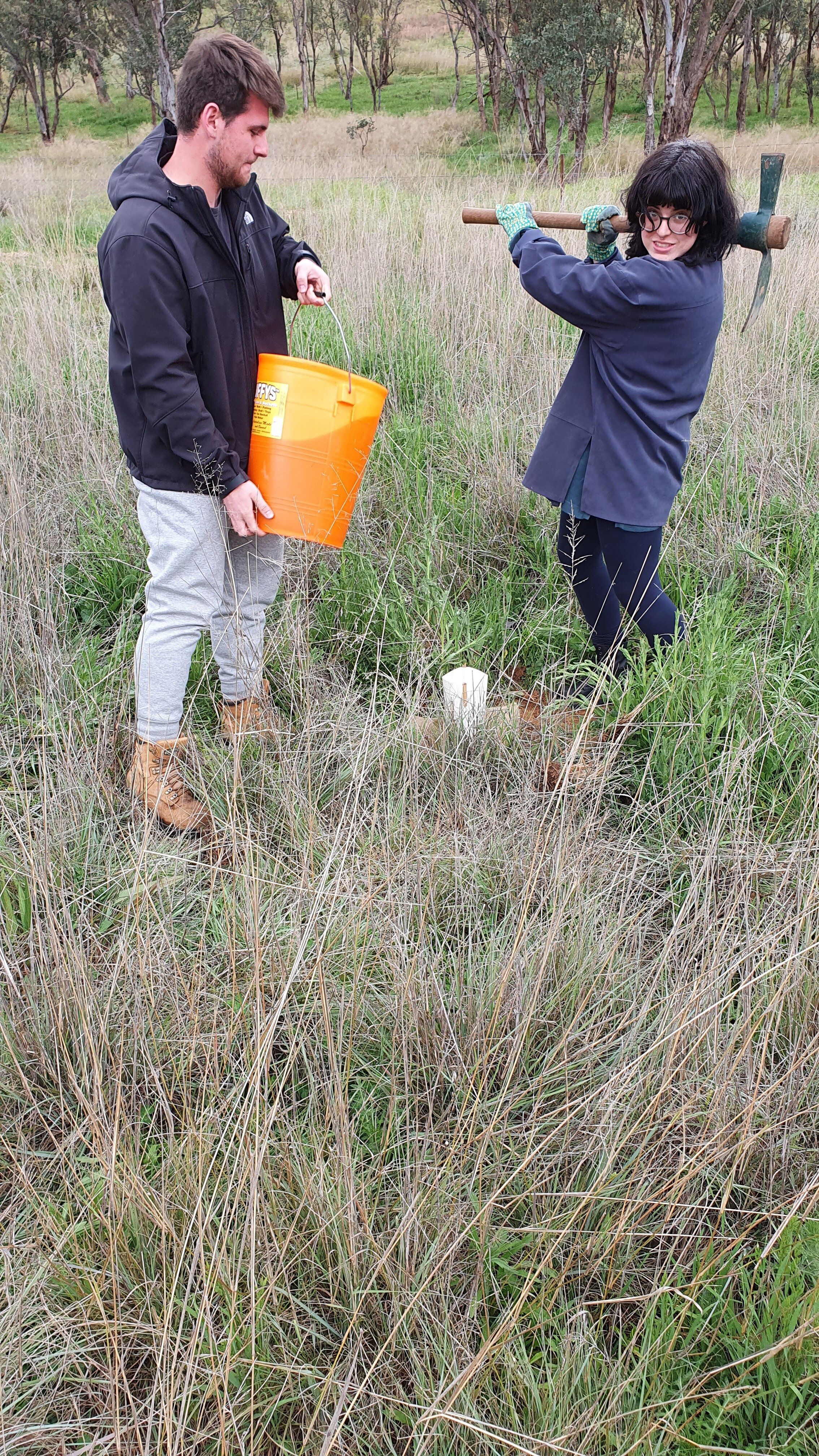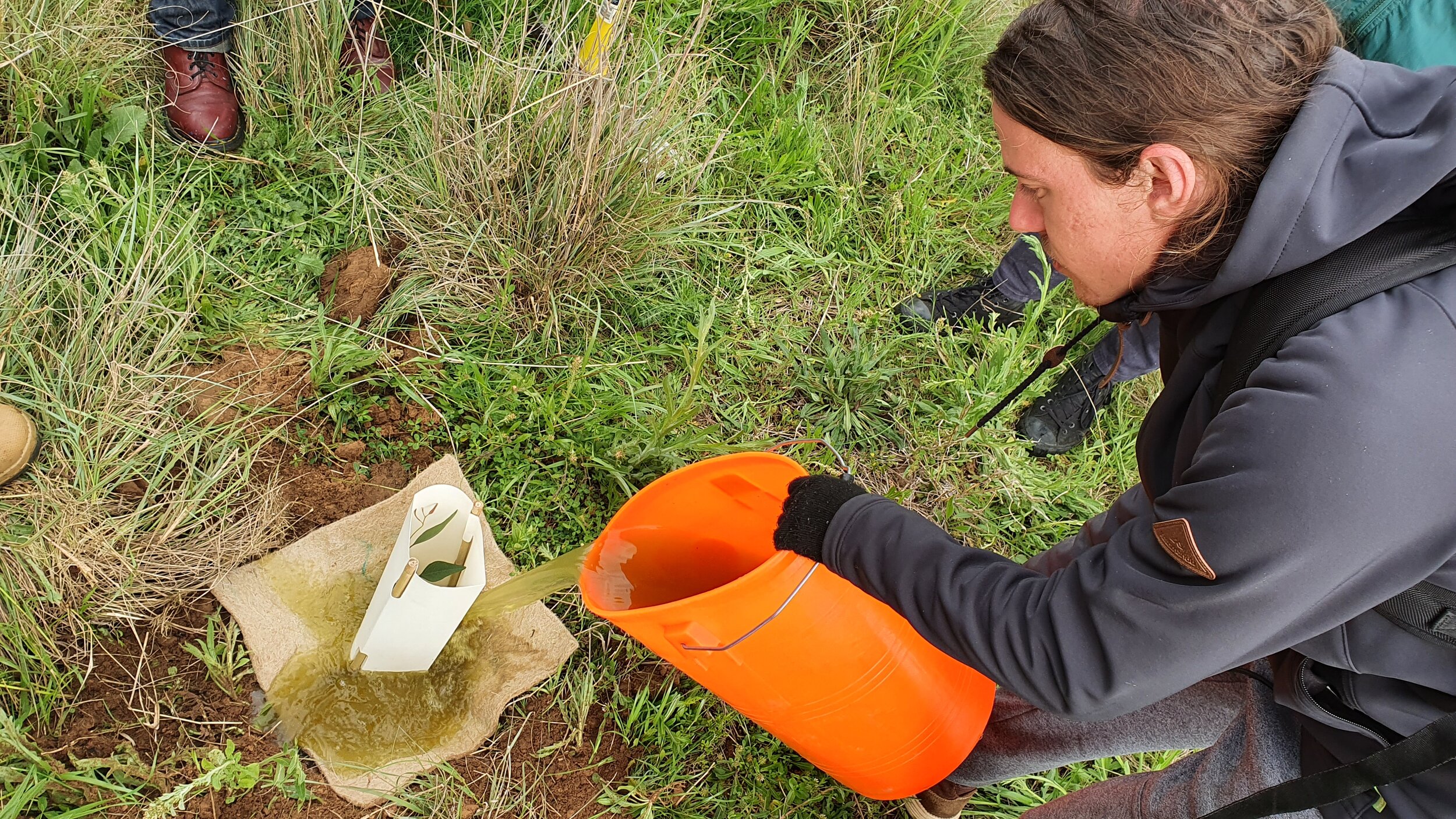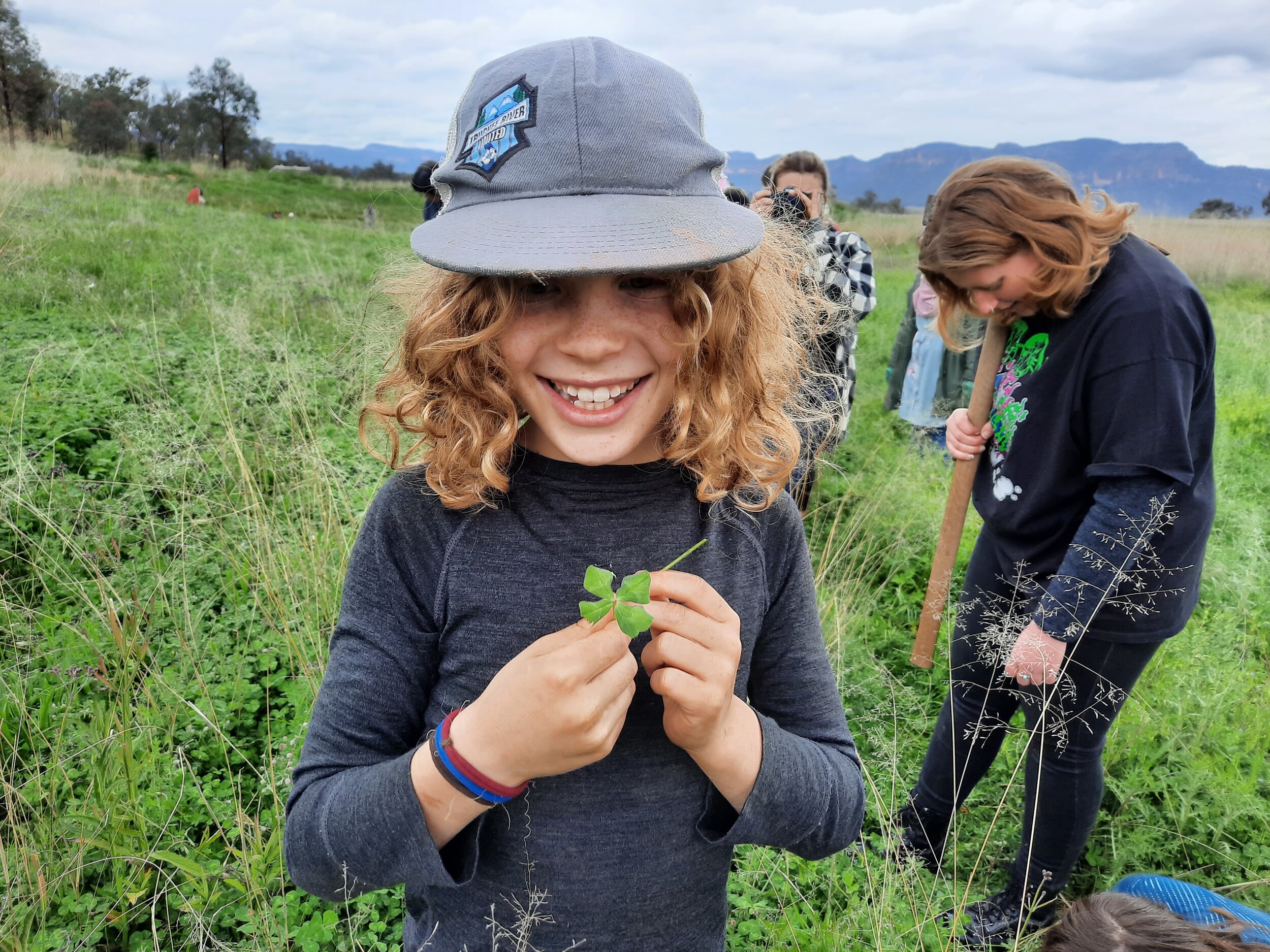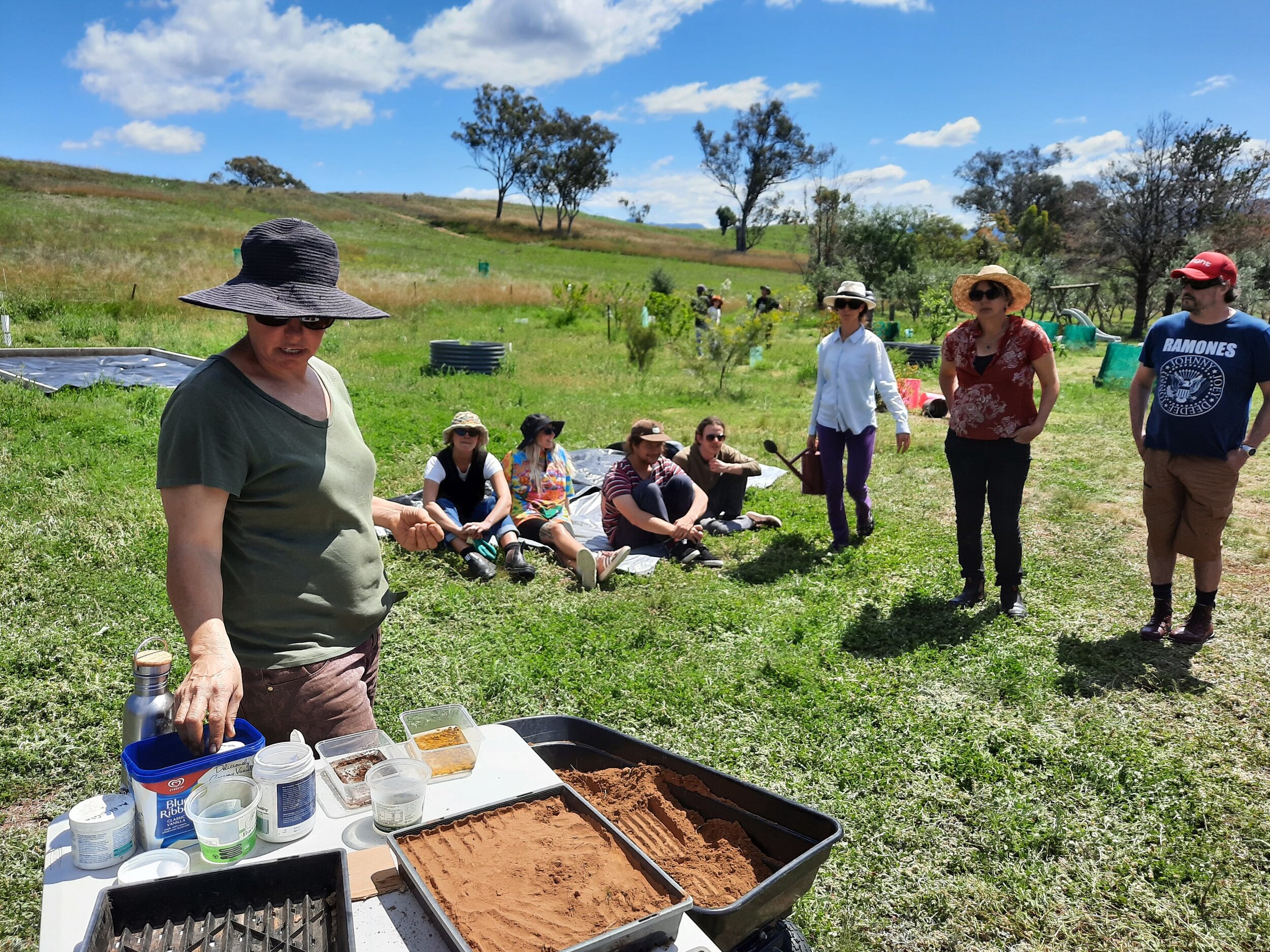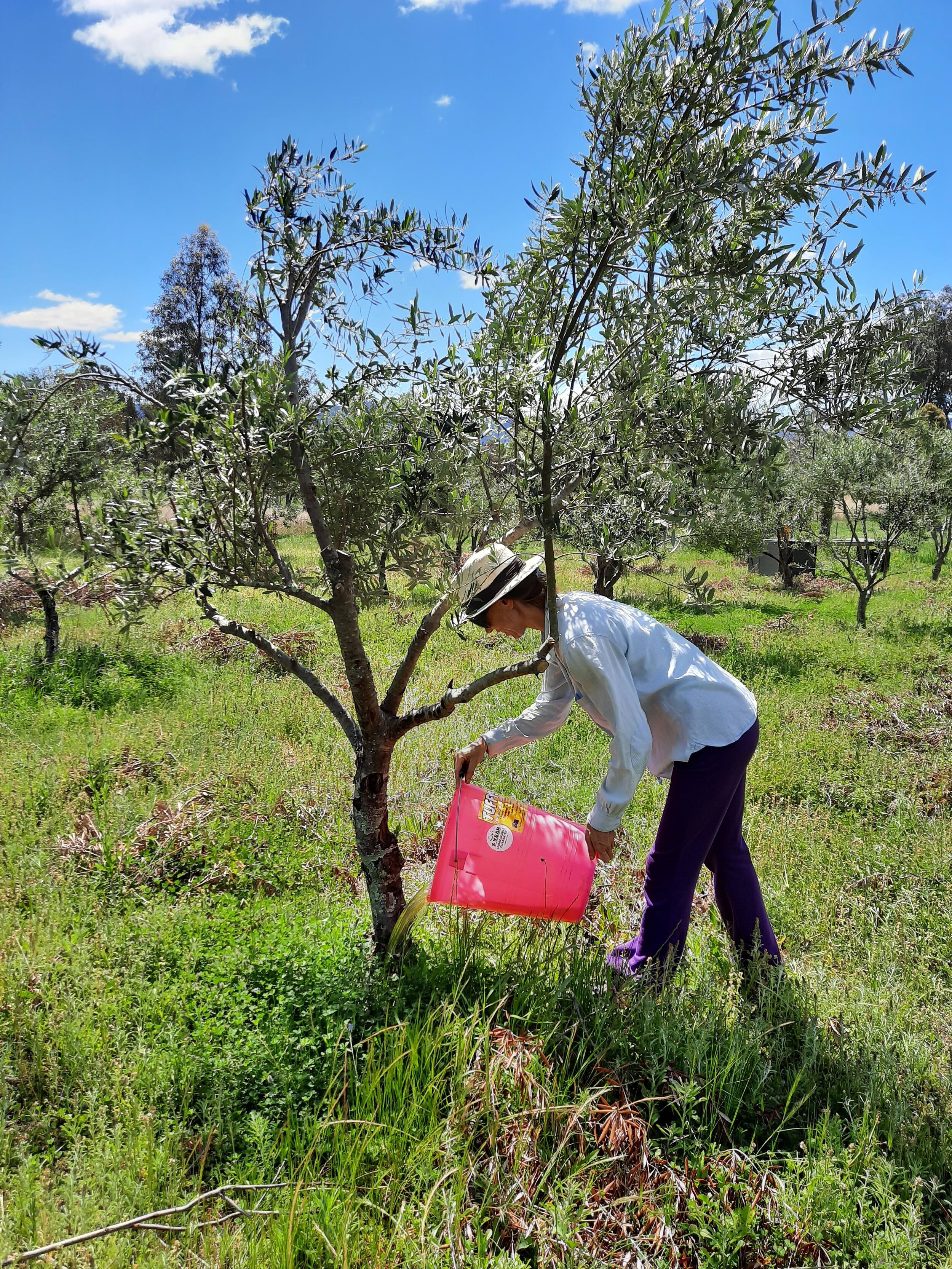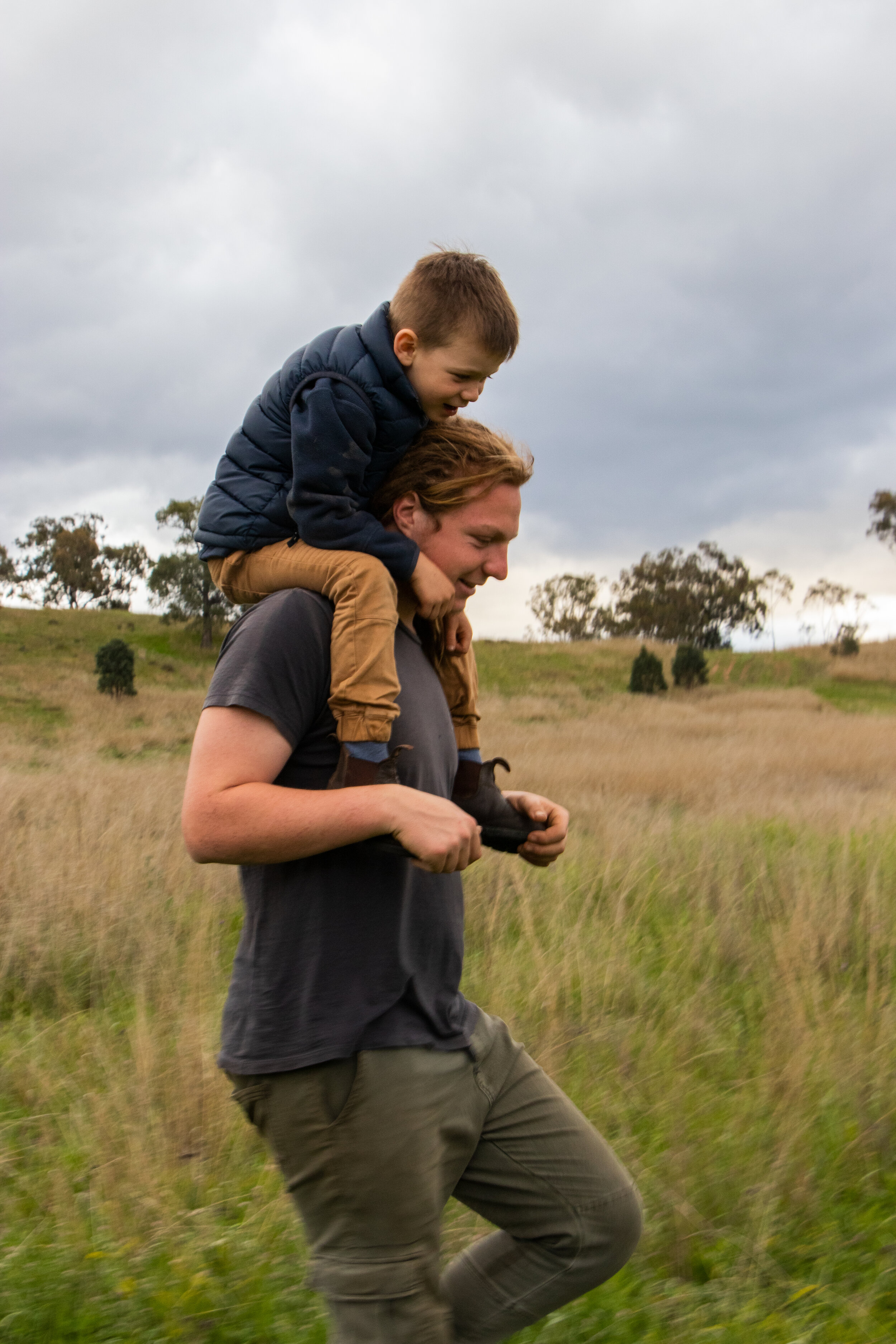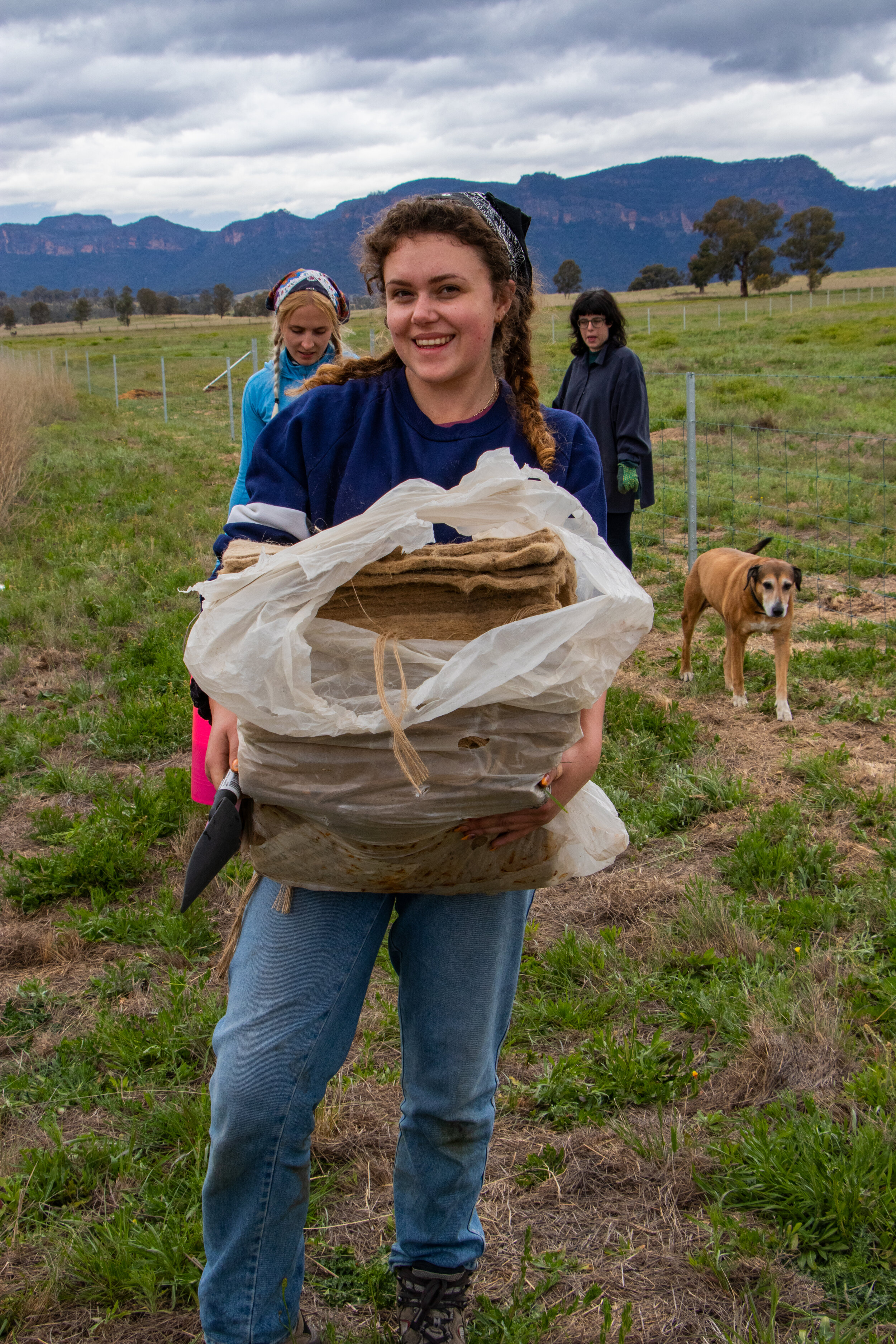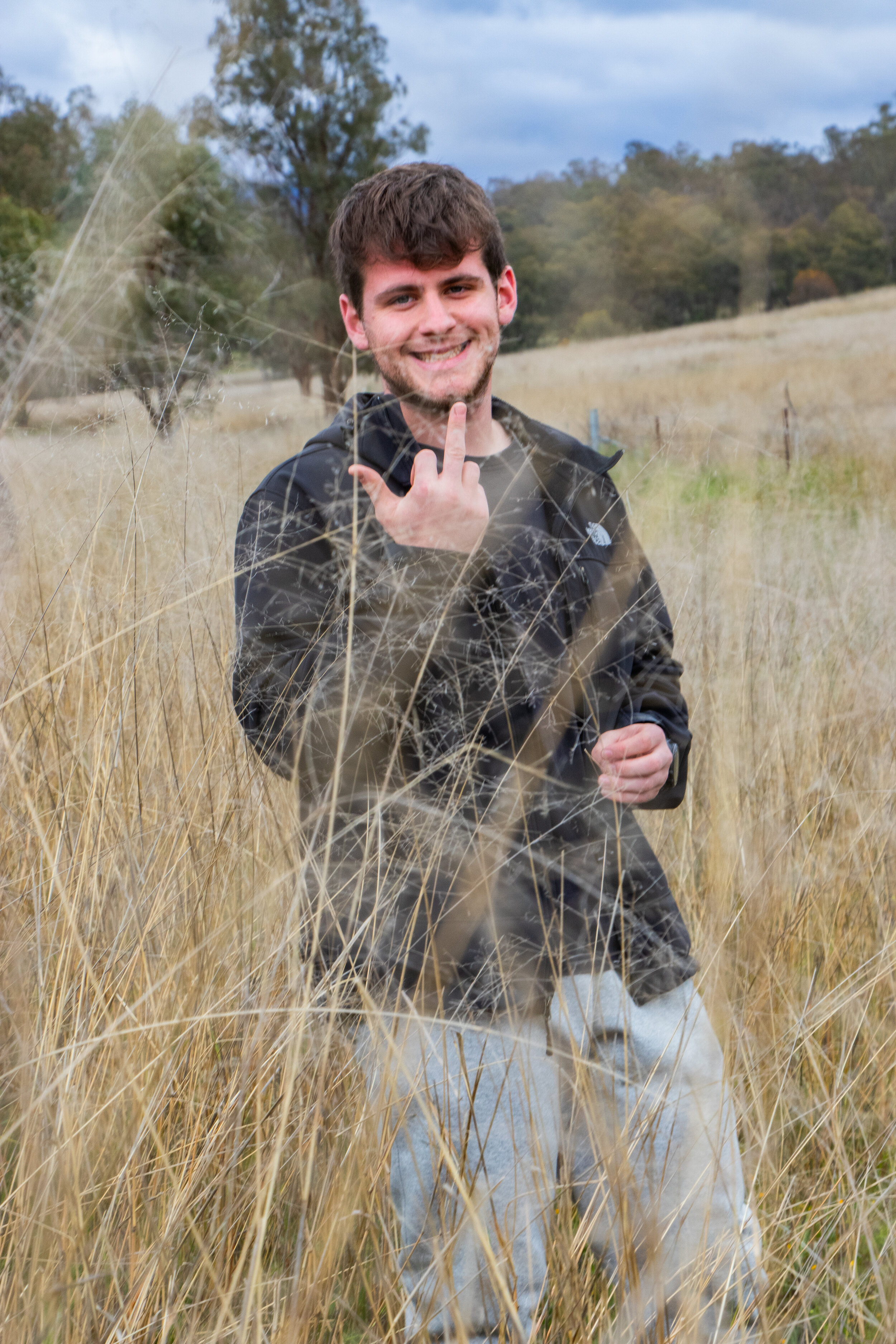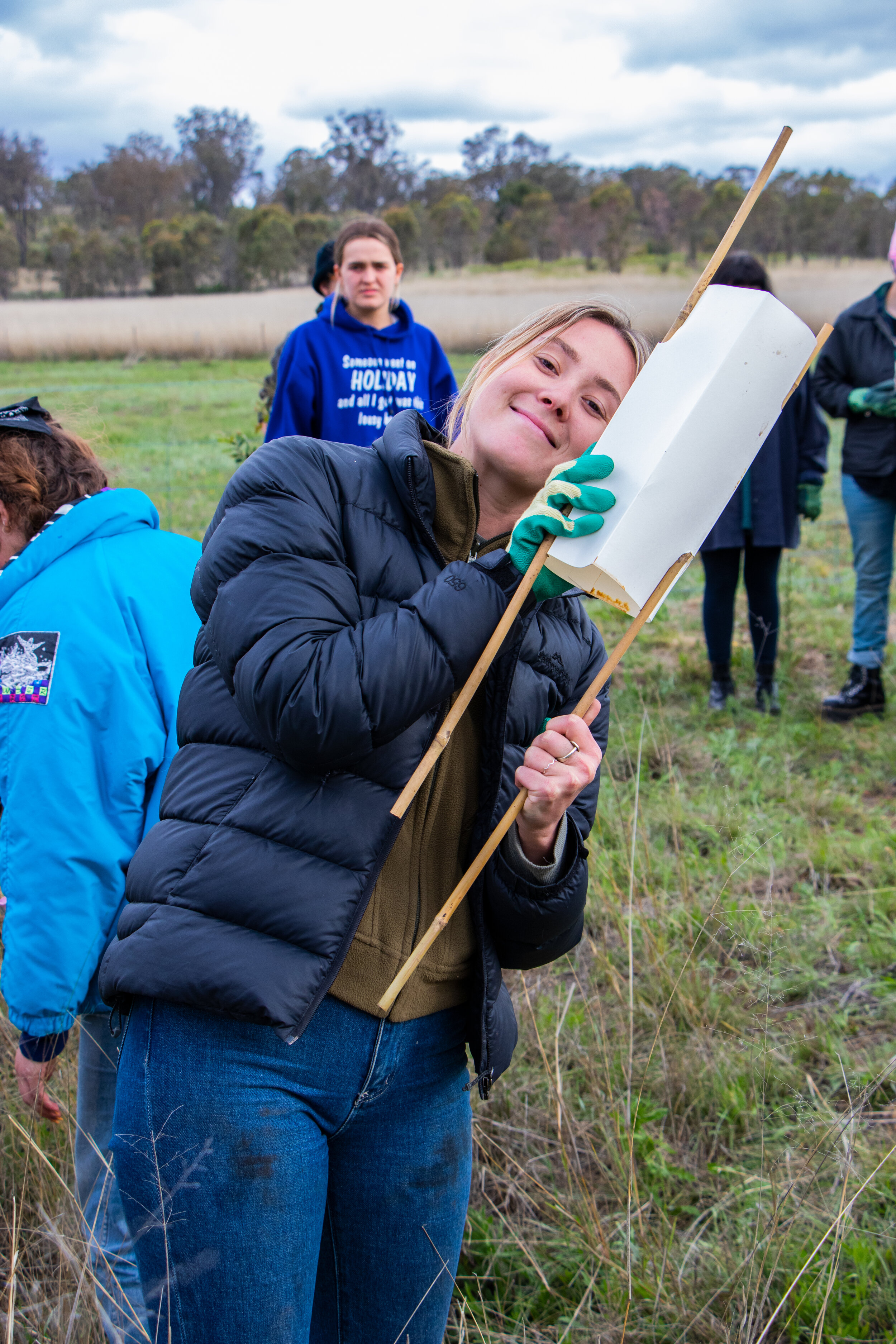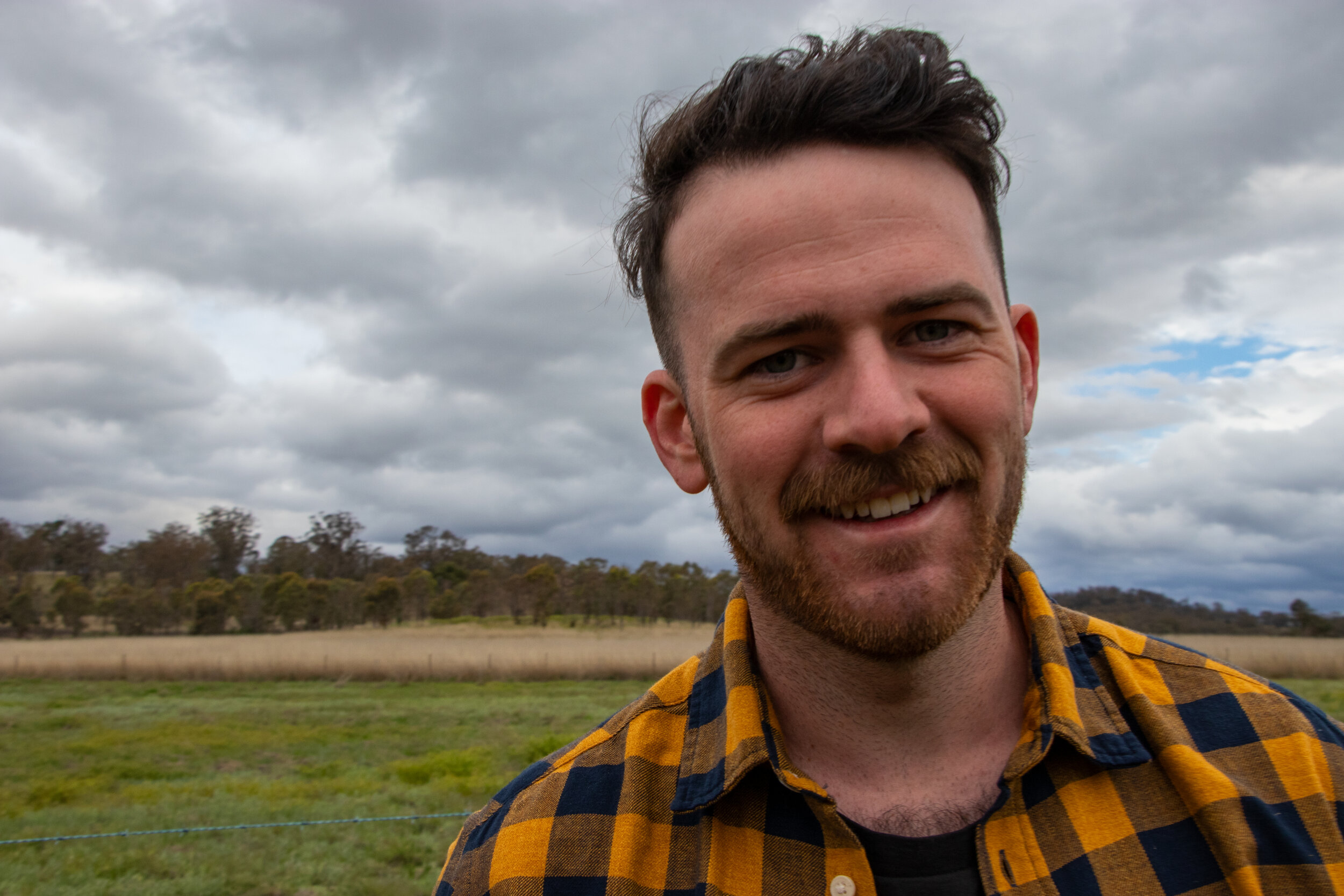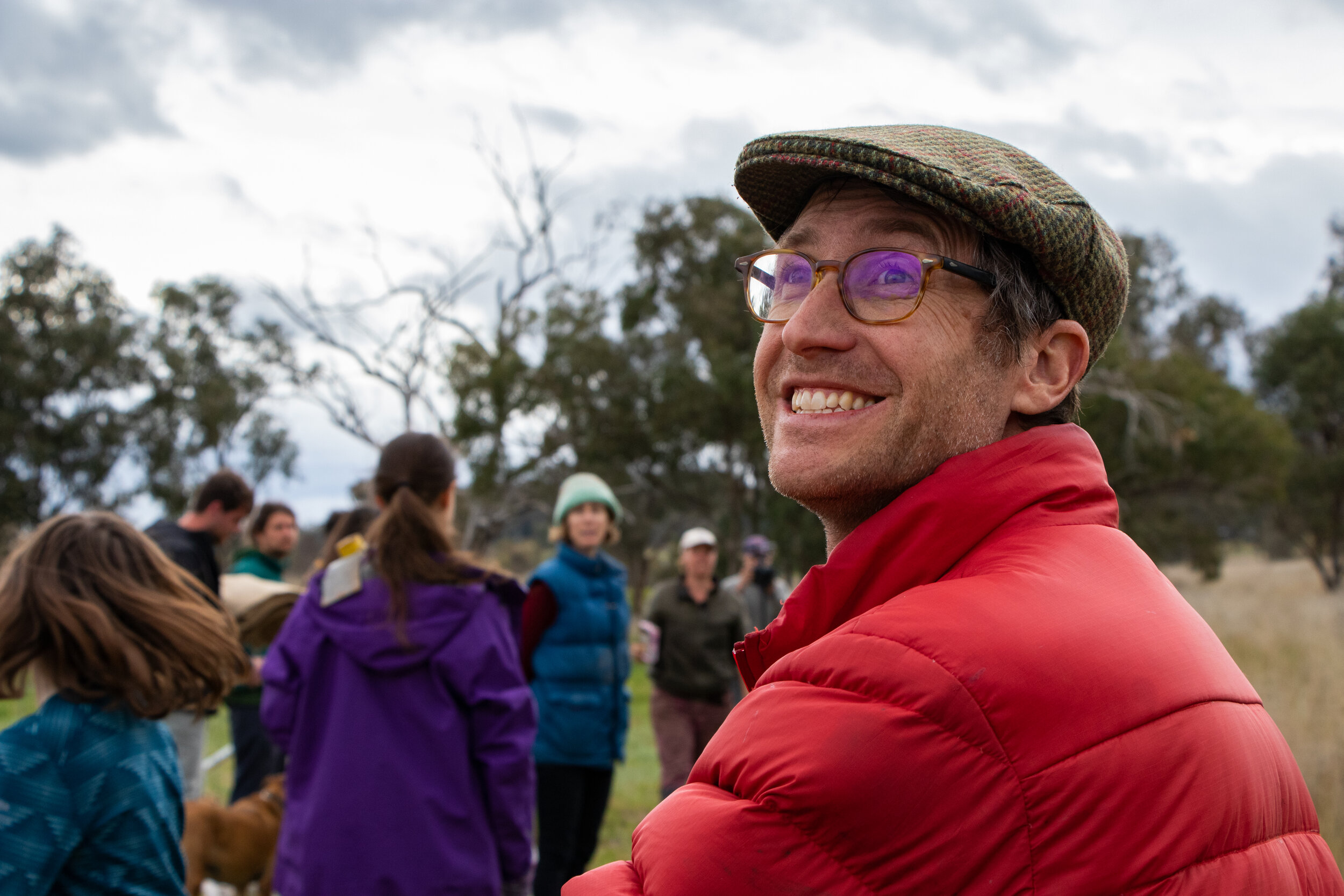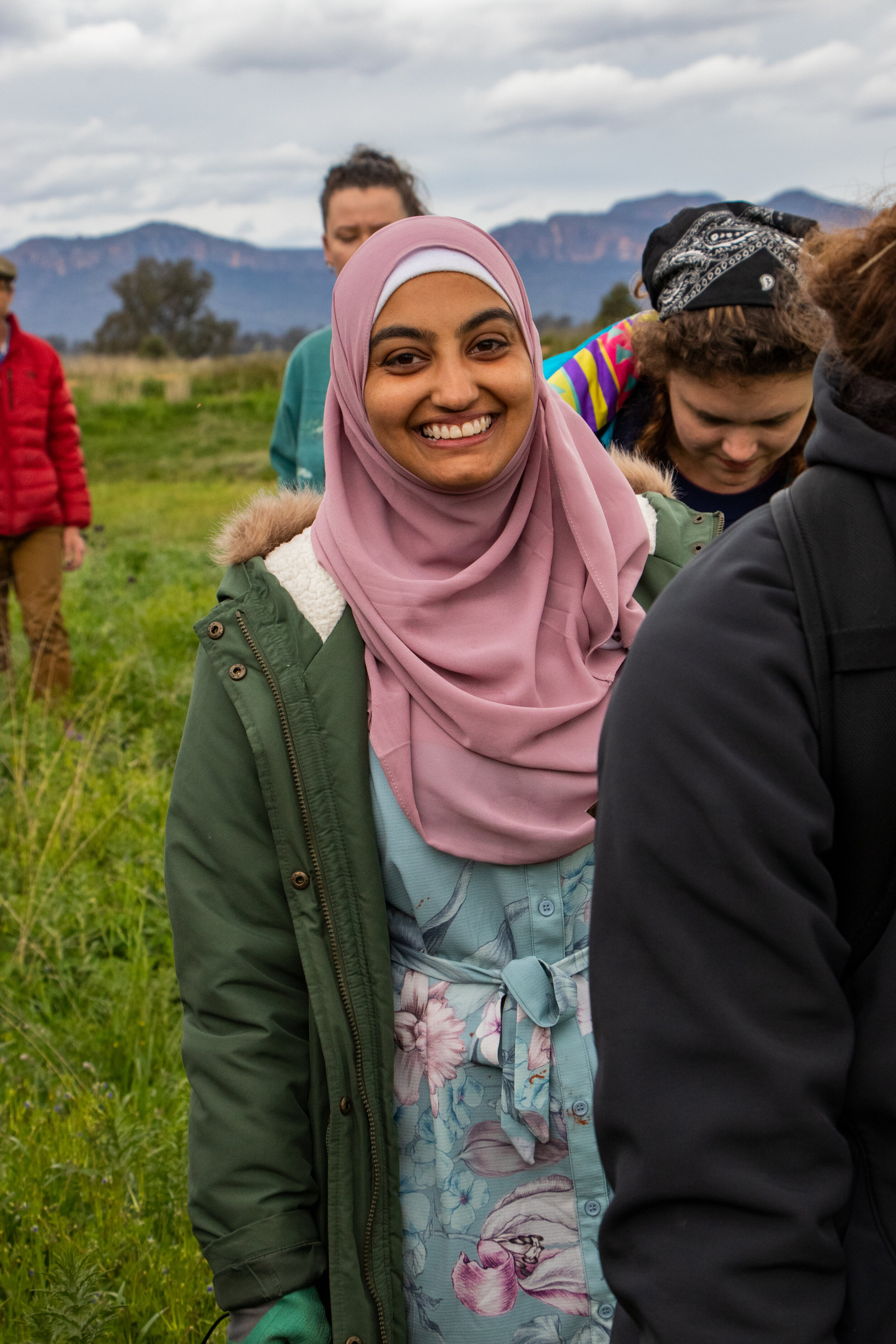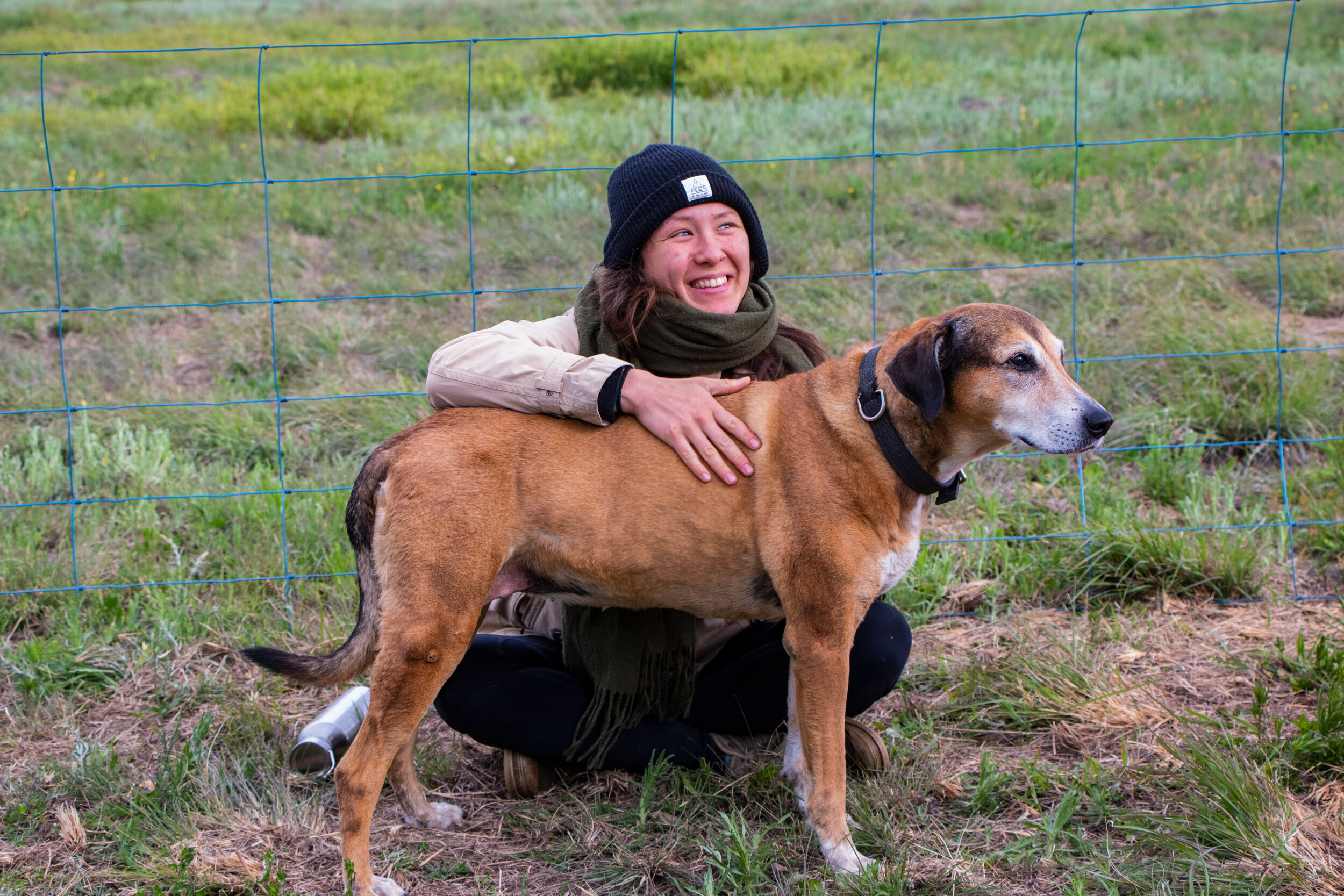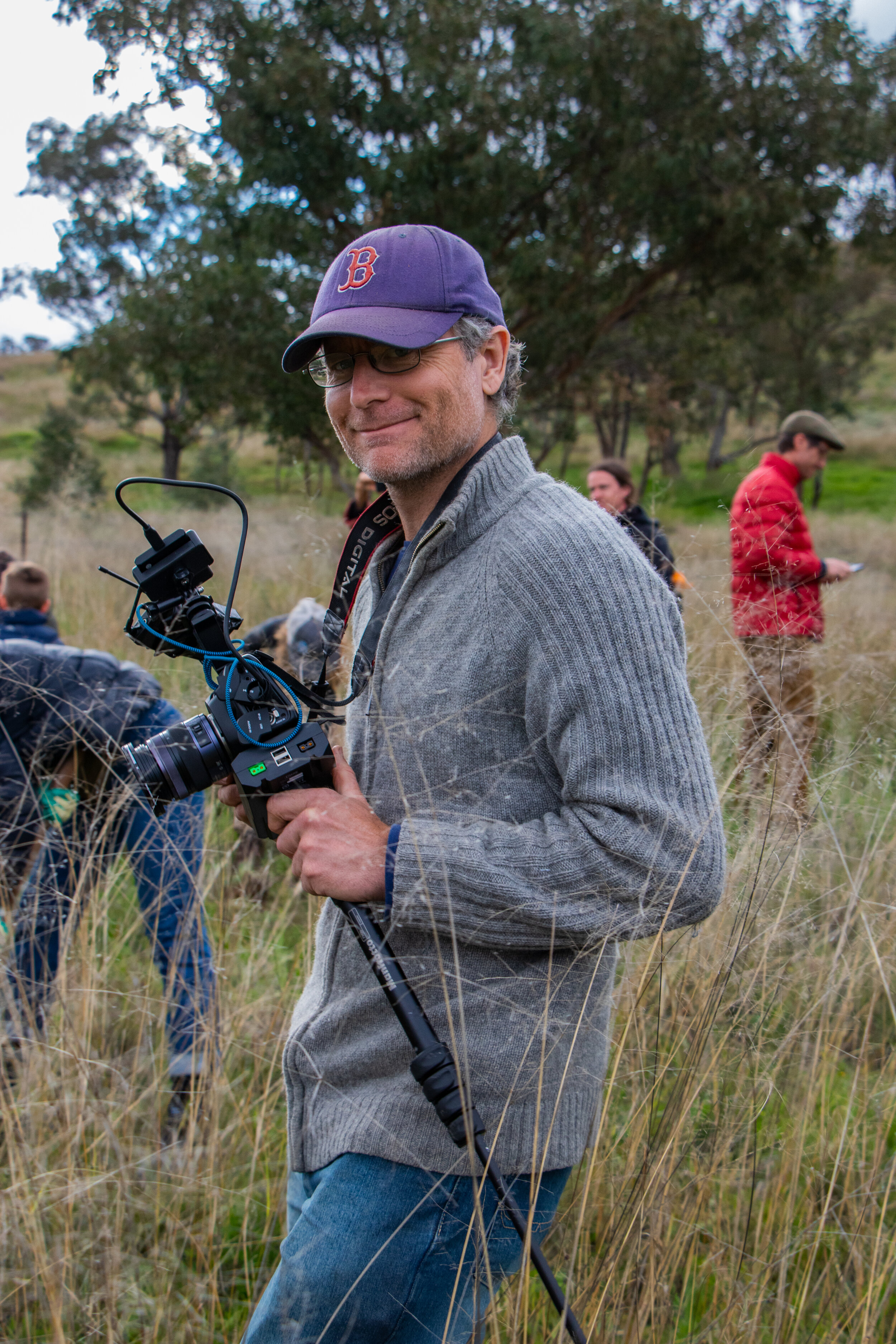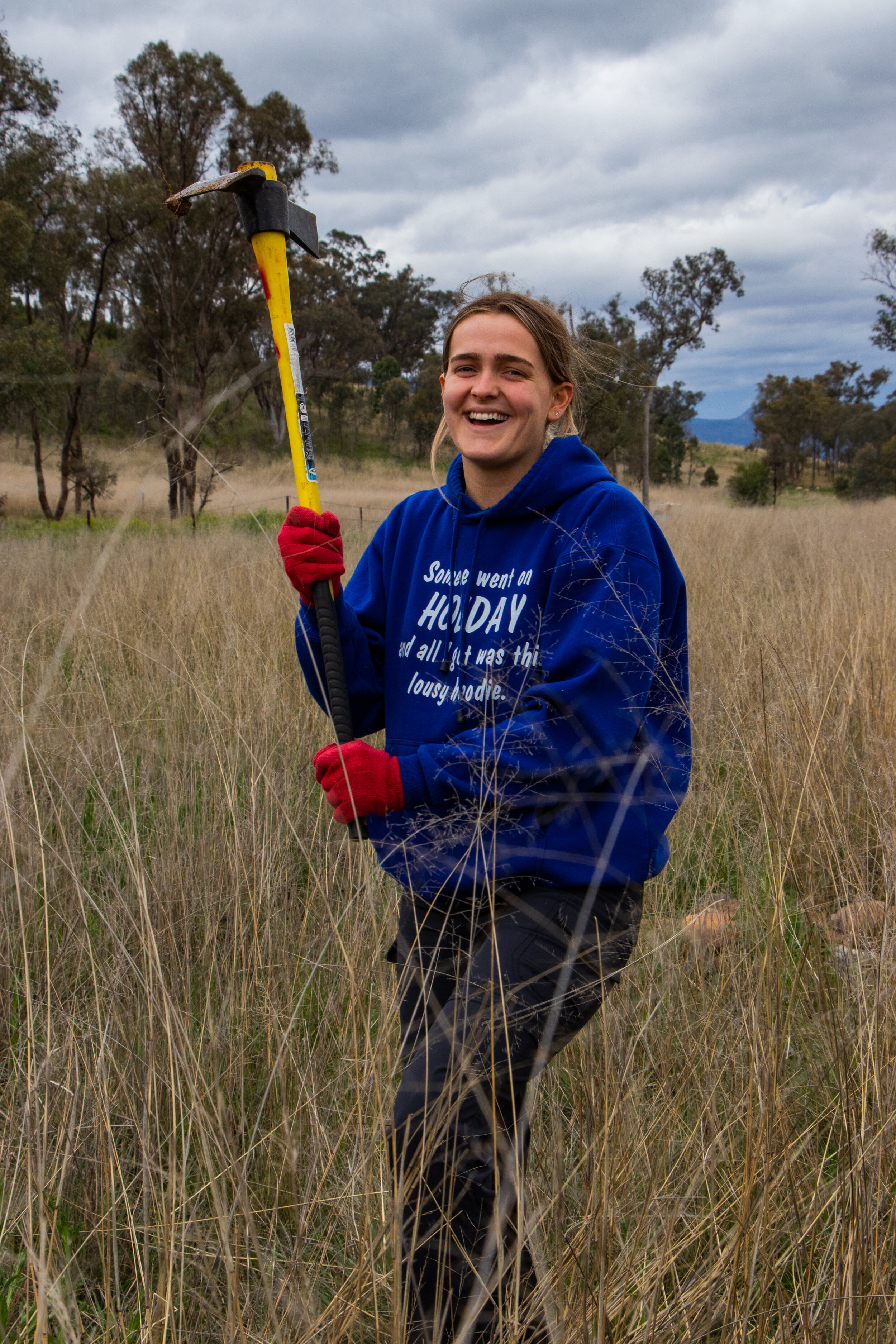By Laura Fisher
Land Studio is an idea that sprung from the incredible collaborations that formed ‘An artist, a farmer and a scientist walked into a bar…’ We had witnessed how farmers who wanted to restore degraded land, transition to regenerative methods and make their land more resilient to climate change worked incredibly hard to incorporate those additional tasks into their working week. What could we do to turn this problem into a pleasure? Perhaps we could help with practical projects in the communal spirit of barn-raising and harvest traditions of the past. Maybe we could bring art, farming, science and Indigenous knowledge together as part of the journey, drawing on what the AFS project had taught us?
Kerrie Cooke from Capertee Valley Landcare, a good friend to KSCA who has led many native tree plantings in the Valley, had also been thinking along these lines. After attending our event Groundswell in Bingara a year ago, she left inspired by the idea that artists could play a role in her community’s efforts to restore their waterways. She, Leanne, Georgie and Alex then instigated the Capertee Resilient Farmers Project with its KSCA thread, The Capertee Hydrology Project. Kerrie also connected with The Mulloon Institute, an organisation that has put Peter Andrews’s Natural Sequence Farming innovations into practice over many years in synergy with other regenerative methods. Kerrie had long dreamt of hosting university students out in the Valley, and she and I began to talk about how that might happen.
In late 2019 a NSW Government grant for community-led projects that supported climate change resilience and adaptation popped up. KSCA submitted a proposal with the aim of piloting Land Studio in partnership with Capertee Valley Landcare, The Mulloon Institute and the University of Wollongong. Lucas teaches a course called ‘Art, Nature and the Environment’ there, which was a good match for a Land Studio trial.
I wouldn’t normally dig into the grant criteria in a blog like this, but this was an interesting one. Each proposal had to be anchored to the climate change impacts predicted for the relevant region. According to the “climate change snapshot for the Central West and Orana region”, in the coming decades the Capertee Valley will face:
More hot days
Reduced spring rainfall
An increase in average and severe Forest Fire Danger Index (FFDI) values
Increasing weather extremes (drought and floods).
When we submitted the grant proposal, in the midst of the bushfire crisis, this was all too real.
By the time we heard that we’d been awarded the grant in early 2020, Covid 19 was upon us. As happy as we were, a question mark hung over the project for many months. Finally, with the number of community-transmitted cases in NSW reassuringly low and a covid safety plan in hand, the university gave us the green light to stage a 4 day camp with 23 students and staff in spring.
Have a watch of this video about the camp, or read on below for more blog and pictures!
We set up camp at Snowgoose Farm, the 100 acre property of Emily and Stuart Dawson. They run sheep for wool, raise and sell grass-fed lamb and have adopted regenerative methods like multi-species cropping. We were graced with a sunset welcome to Wiradjuri Country by Dabee artist Peter Swain. The students all responded to the values of stewardship, connectedness and healing he shared. The campground (with its 4 freshly built loveable loos made by Lucas) soon had a village feel, with everyone absorbing the magic of sitting around the campfire sharing stories, giggles, music and savouring Alice Wood’s delicious catered dinners.
The very lovable Stuart, Sammy and Emily Dawson of Snowgoose Farm.
…and a very lovable loo.
Photos of Peter Swain’s welcome by Bodhi Todd
Besides Snowgoose, we spent a lot of time at Umbiella, an historic property run by Terrie Wallace and Stuart Knox in the centre of the Valley. They have been slowly turning Umbiella around, regenerating it from the highly degraded state it had reached in recent years. They run grass-fed sheep and cattle holistically to rest the land, avoid chemical inputs and sow multi-species crops. They are trialing some natural sequence farming concepts as well.
With guidance from Peter Hazell from Mulloon, and with Kerrie’s boundless knowledge of the plant communities in the Valley, we planned activities that could involve students, community members and farmers. Most of these activities revolved around the need to rehydrate the landscape to build its resilience to climate extremes. The guiding principle was ‘slowing the flow’: dissipating the erosive energy of water when it moves at speed (as it does on any degraded land) so it can have time to sink into the soil, and be encouraged to form into chains-of-ponds and wetlands linked to hydrated floodplains.
The first project we did was a pin weir to support the rehabilitation of a creek at Umbiella that is deeply eroded (as can be seen in the image above with Peter Hazell). Locals Dom, Tony, Chris and Gianluca taught us how to use a scythe, which turned out to be an addictive activity for some of us! We then piled those scythed grasses against wooden stakes that we’d hammered in to the ground, creating a 30 metre wide weir. The weir will slow down the water and filter it, holding back the sediment that water-loving plants will take advantage of. The students heard from both Peter and Bill McAlister about how this simple intervention can encourage water to meander more slowly across a landscape. Rather than being a destructive, erosive force, it becomes a builder of soil, vegetation and habitat.
We also made small rock weirs with Terrie Wallace, working with the water flows in a more contemplative and intimate way further up the creek.
Terrie Wallace guiding the river activities.
Another major activity involved helping KSCA comrade Leanne Thompson build her contour sculpture at Umbiella. Called Capertee Weaving Water, this work is part of the Capertee Hydrology Project and highlights the importance of contours in the landscape and of plants that help to hold water. Like weirs, a contour can be a tool for interrupting water’s downhill trajectory and encouraging it to spread horizontally and soak in. The students helped Leanne create a thick, twined rope made of harvested phragmites (reeds), 130 metres long, that formed a very striking contour line visible from the road (you can watch this video to hear Leanne speak about the importance of phragmites and the intentions behind this symbolic contour). This contour formed the basis for an extraordinary land sculpture that evolved in the following weeks, as Leanne incorporating weavings created by community members - there will be a future blog post about this!
Peter Hazell’s drone picture of the 130 metre long contour line.
We also planted 100 trees at Snowgoose Farm. We did this at the lowest part of the property where water flows periodically, and where there are two dysfunctional dams. Emily and Stuart would like to remove these dams and renaturalise this spot. Kerrie selected 100 native species that like to have ‘wet feet’, and which will create root systems that draw up nutrients and hold water, supporting the regeneration of the entire landscape. Alongside the pin weir and the contour, this was the third illustration of a strategy for ‘slowing the flow’ and holding water in the landscape. Everyone worked happily into the early evening, sharing tasks and chatting, admiring the full moon as it rose over the escarpment. Grown by Kerrie and her partner Dom at their own nursery, all the plants were the progeny of Capertee Valley trees. Their species names are Acacia filicifolia, Acacia montana, Acacia falciformis, Melaleuca lanceolata, Casuarina cunninghamiana, Eucalyptus meliodora, Eucalyptus sideroxylon, Callistemon citrinus and Angophora floribunda.
Kerrie and Leanne at left discussing the best spots to plant.
On the final morning we learnt how to propogate native seed, and gave the Snowgoose Farm orchard some microbial love with a soil bacteria tea Kerrie had cooked up using goat’s whey (left over from the cheese she makes every morning, from the milk from her neighbour Tony’s goats!). This gave us a chance to talk about the very very tiny things we rely on in our soil, in our food and in our guts.
We then took the students to Kandos, where we had sandwiches and heard Georgie talk about the fine textile-like collages she’s making for the Capertee Hydrology Project that reinvent the idea of a map, and Alex talk about the thrills of running our favourite contemporary art festival, Cementa, and the new Way Out Gallery.
Epic indeed.
The Valley was vibrating with colour and life after recent rains. We were also pretty joyful and lively, it must be said. This was just the first stage of the Land Studio pilot, which will carry on into next year: it’s a model we aim to improve upon and vary in collaboration with other farmers, community members and knowledge-holders. Feedback from the students has been hugely positive, with a few having already returned to the Capertee since the camp to connect with new friends.
Thank you to our beautiful farmer hosts Emily and Stuart, and Terri and Stuart, and the Capertee crowd: Kerrie, Dom, Tony, Gianluca, Chris and Julie, vollies Nick and Rachel, Alice for preparing our delicious food, Justin Hewitson for making videos, Peter and Bill from The Mulloon Institute, Michael and Billy from Dry Creek Farm, Peter Swain, Auntie Di, Alex and Georgie, Gary Jones (co-coordinator of ‘Art, Nature and the Environment’ at the Uni of Wollongong), and to all the students for their hard work and smiles contributing to the regeneration of the Capertee Valley! Grateful thanks also go to the NSW Department of Planning, Industry and the Environment for funding the Land Studio Pilot Project. Unless otherwise stated, all photos in this blog were taken by Alex Wisser, Laura Fisher and Lucas Ihlein.
Photo by Bhodi Todd. Below are some amazing portraits taken by Kiana Elford.

